Dreamgirls (PG-13)
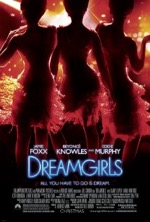
Starring: Jamie Foxx
December 2006
“With These Girls…Life is But a Dream”
If movies could mate, Dreamgirls would be the cinematic offspring of Ray and Chicago. The movie, though fictitious, is reminiscent of real life music sensations such as The Supremes and The Temptations and reflects the offstage struggles those groups (and many others like them) experienced when fame exacted too high a price from some of their number. Based on the book by Tom Eyen and the musical of the same name, it was long maintained that Dreamgirls could never be adapted into a screenplay, but now, thanks to writer/director Bill Condon and a scintillating cast, Dreamgirls has finally made the transition from Broadway to big screen.
The story focuses on three friends—Effie (Jennifer Hudson), Lorrell (Anika Noni Rose) and Deena (Beyonce Knowles)—who work their way to the pinnacle of musical success during the 60’s. Along the way, the singers fall victim to the various pitfalls of the industry; unethical managers, song stealing opportunists, producers who sell out to reach a broader audience, drugs, sex and the list goes on and on.
Singing backup for Jimmy “Thunder” Early (Eddie Murphy) gives the trio the exposure and popularity they need to break out on their own. However, just as the group starts to take flight, manager Curtis Tabor Jr. (Jamie Foxx) stirs up a hornet’s nest when he decides to relegate soloist Effie to backup duty so that he can elevate Deena to lead singer…because she’s easier to look at and will attract a younger crowd. Effie, who refuses to sing “oos” and “ahs,” walks out on the group, a la David Ruffin.
Dreamgirls closely parallels Chicago in its use of musical interludes to further the story, and let’s face it…the movie is the music. There isn’t a single song in the film that doesn’t deserve Oscar consideration for Best Song. Jennifer Hudson, in her screen debut, steals the show with her concussive chest voice—she can flat-out wail! In some ways, Hudson’s personal story is more inspirational than Effie’s—she’s gone from American Idol reject to movie star in just over a year…quite an accomplishment.
The dazzling costumes and sets are certainly worthy of mention, but while passing out accolades it’s impossible to avoid highlighting the superlative cast: the three female leads, along with Foxx and Murphy, are nothing short of stellar, and the expansive supporting cast includes such notables as Danny Glover and John Lithgow.
Though Dreamgirls didn’t reach me like Chicago did, it isn’t difficult to see the movie’s appeal: it’s an entertaining film that boasts show-stopping musical numbers and a genuinely human story. So, to any other musical movie with aspirations of surpassing Dreamgirls this year…dream on!
Rating: 2 1/2
We Are Marshall (PG)

Starring: Matthew McConaughey
December 2006
“We Are…Mildly Inspired”
Widely regarded as the worst tragedy in the history of collegiate sports, the Marshall University football squad, after suffering a 17-14 loss to East Carolina on November 14, 1970, boarded a plane that crashed in mid-flight. There were no survivors. The new movie based on that horrific true account, We Are Marshall, focuses on the process and politics involved in rebuilding the school’s football program.
The unenviable task of finding a replacement football coach falls on Marshall’s president, Dr. Don Dedmon (David Strathairn). As fate would have it, the last person on Dedmon’s list, Coach Jack Lengyel (Matthew McConaughey), accepts the position; Jack’s passion for life and football stands in stark contrast to the grief-stricken community of Huntington, WV. There’s a great scene where Jack approaches Red Dawson (Matthew Fox) to be his assistant; Jack learns that fate guided Red’s decision to drive home the night of the crash. Sympathetic but firm, Jack challenges Red to stop wallowing in his pool of self-recrimination and get on with living…Red accepts the job.
Ian McShane (Deadwood) plays the chairman of the school board, Paul Griffen. Paul, an embittered shell of a man whose son was one of the 75 casualties, opposes the groundswell movement to reinstate the football program and threatens to fire Dedmon if the president doesn’t change his position. If Paul has a soft spot it’s for Annie (Kate Mara), the fiancée of Paul’s deceased son. The scene where Annie returns her engagement ring to Paul is one of the movie’s most moving moments.
As would be expected, the film has its fair share of football sequences, which serve as brief respites from the unrelenting, heavy-hitting drama. Thankfully, the film doesn’t get bogged down in the kind of play by play minutiae we’ve seen in some other football movies—the story here focuses on the team and community, not on some glorious championship game. In fact, the movie ends, unconventionally, right after the second game of the ’71 season. Even though writers Jamie Linden and Cory Helms do a good job of balancing game elements with character interplay, the story is still just as predictable as the Power I formation. Further, the movie’s resolution has too much hang time and is overly sentimental, especially for a testosterone-infused gridiron film.
Other fumbles were committed by the technical teams: poor sound mixing, disjointed editing and shoddy direction by McG. On the flip side, the cast does an excellent job in roles that very easily could’ve become stilted. McConaughey steals the show with his portrayal of enthusiastic, dynamic and charismatic Coach Lengyel—nothing seems to get him down and his eternal optimism (like when he asks rival coach, Bobby Bowden, for pointers on how to run the veer) is downright inspiring.
As long as you’re willing to lower your expectations a bit (this isn’t Rudy or Remember the Titans), We Are Marshall will fill the bill if you need an inspirational sports flick fix. We Are Marshall serves its purpose with solid performances and a faithful script, but would loose by a late touchdown to other top-ranked football movies.
Rating: 2 1/2
Night at the Museum (PG)
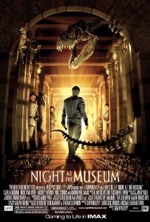
Starring: Ben Stiller
December 2006
“One of Our T-Rex’ is Missing”
All too frequently these days, movies are ruined by comprehensive trailers. Serving as a visual Cliff Notes version of the film, said trailers spell out the plot and leave little to the imagination…and little reason to shell out a ten spot to see the picture. Of the recent movie-spoiling trailers, the Ben Stiller vehicle, Night at the Museum, is the worst offender of all, revealing nearly every major plot point in the preview. As egregious as that is, it’s an even greater tragedy that the movie fails to build on what, at first glance, appeared to be a highly entertaining, crowd-pleasing comedy/adventure.
The movie’s premise is elementary, much like the plot: Divorced dad, Larry (Stiller), keeps moving laterally from one dead-end job to another and has more money-making schemes than Ralph Kramden. Despite his best efforts to be a hero to his preteen son, Nikki (Jake Cherry) he always comes off looking like a schmuck. Desperate for employment, Larry takes a night security position at the Museum of Natural History in NYC to appease his landlord and ex-wife (24’s Kim Raver). In an unpopular move made by management, Larry is replacing three dotting guards: Cecil (Dick Van Dyke), Gus (Mickey Rooney), and Reginald (Bill Cobbs). Before cleaning out his locker, Cecil gives Larry this piece of advice, “Don’t let anything in or out!”
Larry’s first night on the job is uneventful until he notices the vacated T-Rex dais. A tour around the labyrinthine hallways confirms his worst fears…everything in the museum is alive! The chaos that ensues is tantamount to Jumanji in a museum. I mention Jumanji here because of its thematic and structural similarities to Night at the Museum and because its star, Robin Williams, appears here as Theodore Roosevelt, the person Larry turns to for wisdom and assistance when all Valhalla breaks loose.
After five minutes of mischievous monkeys, aggressive lions, defiant pygmies, talking sculptures and belligerent Huns, I had climaxed on the menagerie mayhem conceit and was ready to see something, anything else. Unfortunately, the rest of the movie, save one twist near the end, focuses solely on the enchanted museum and the anarchy that exists from midnight to dawn…at which time everything in the museum magically “resets.”
Character development is exceedingly tenuous and the story written by Ben Garant and Thomas Lennon (based on the book by Milan Trenc), is so pedestrian that it sabotages any possibility for enjoyment. Stiller’s shtick is growing more tedious by the movie and Williams fails to salvage the film with his heartfelt turn as Roosevelt; perhaps because the erstwhile prez makes too many sermonizing speeches and has voyeuristic tendencies where Sacajawea (Mizuo Peck) is concerned.
As the movie closes, Larry supervises a wild party in the main lobby; the museum denizens have finally learned how to peacefully co-exist. Such movie-ending revelry worked like a charm in Shrek, but here the celebration seems contrived and more than just a little bizarre. It’s a shame that the word bizarre has to be applied to a movie that seemed primed to become the newest sensation to sweep the comedy genre. Guess it just goes to show that you can’t judge a book by its cover…or a movie by its trailer.
At one point, while dealing with escaped animals and blood-thirsty natives, Larry remarks, “This is so not worth $11.50 an hour.” Neither is forking out $9.50 for two hours of this!
Rating: 2
The Pursuit of Happyness (PG-13)
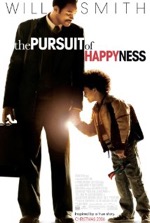
Starring: Will Smith
December 2006
“How Determination Overcomes Marginalization”
Peering through the diamond shaped openings of an eight foot tall metal fence, Chris Gardner (Will Smith) surveys the cold, uncaring skyscrapers that have hemmed him into the prison-like confines of a craggy, weed-ridden basketball court. Standing at Chris’ side is his pouting son, Christopher (Will’s real-life son Jaden in his acting debut). Chris turns to his son and, with tension in his voice and tears in his eyes, says, “Hey. Don't ever let somebody tell you... You can't do something. Not even me. All right?”
Never before and never since have I welled up during a movie trailer. I was genuinely moved, not only by the power of the words themselves, but also by the sheer force of conviction that had impelled them. In the margin of my review notes, for whatever movie I was watching that day, I jotted down the movie’s title to make sure I kept an eye out for it. That movie, of course, is The Pursuit of Happyness, which is based on Gardner’s memoir of the same name and is the latest vehicle for Smith, who turns in his finest performance to date.
The film is based on the incredible true story of how Gardner, a homeless man struggling to raise his son on his own, achieved the impossible by landing a highly competitive internship at Dean Witter with nothing more than the fire in his belly and the clothes on his back. At its heart, Pursuit is a film about a man desperately trying to do right by his son while attempting to make his way in the world. However, as an under-educated African American man living in the early 80s, Gardner exists in a world where the deck has been cruelly stacked against him. With no backup plan, failing to obtain the apprenticeship simply isn’t an option for Gardner.
The movie is told in chapters, each one narrated by the Smith in a conversational manner that’s often amusing, occasionally heartbreaking, much like the narrative as a whole. Smith begins each section with a common phrase: “Now this is the part of the story where…” This opening remark is reminiscent of the internal monologue employed in many films noir or the casual conveyance of inner musings on TV shows like Magnum, P.I. (Magnum had a penchant for saying “I know what you’re thinking…”). Though it grants the viewer direct access to Gardner’s thoughts, one wonders if the story would’ve been just as effective sans the narration. Immaterial, I suppose.
There are several standout scenes in the film, ranging from the serendipitous opportunity for Gardner and his son to watch a 49ers game from an exclusive box at Candlestick to the scene where Gardner frantically tries solving a Rubik’s Cube in a matter of minutes to impress an executive at Dean Witter. By far, the most heartrending scene is when Gardner and his son are turned away by a mission and must spend the night in a subway bathroom. The tears that stream down Gardner’s face as people pound on the locked door to get in, vividly reveal the depth of his plight and the extents to which he’ll go to protect and provide for his son.
Despite its status as a three hanky weeper, Pursuit also has its fair share of comic relief. Case in point: the scene where the nutty homeless guy pilfers Gardner’s bone density scanner and forces Gardner to chase him all over the city to get it back is rather humorous. Though few in number, these instances of levity serve as release valves which vent some of the pressure that’s been building up during the movie’s many Murphy’s Law moments. Without such stress relievers, the movie surely would’ve collapsed under the weight of its own stark reality.
Pursuit is a film that very easily could’ve veered too sharply toward the populist or the melodramatic, but manages to achieve a balanced portrait of Gardner’s turbulent life and career thanks to Gabriele Muccino’s sure-handed direction. Additionally, screenwriter Steve Conrad adroitly negotiates each emotionally charged situation with a parity and panache quite rare among modern “true story” dramas. With its inspirational slice-of-life narrative, which provides a roadmap for how to attain the American Dream the honest way, Pursuit is more salient—and more needed—than ever. Sometimes happiness is the pursuit itself.
Rating: 3 1/2
Eragon (PG)

Starring: Ed Speleers
December 2006
“Medieval Mediocrity Has a New Name”
The best word one could use to describe Eragon, the new fantasy film based on the novel of the same name by Christopher Paolini, is “conventions.” Not sci-fi conventions, mind you, but story conventions. The entire movie is laden with leaden contrivances and borrows heavily from Star Wars (farm boy seeks adventure and is mentored by a seasoned sage), Batman Begins (training sessions), The Beastmaster (conversing with animals), Dragonheart (dragon) and, of course, The Lord of the Rings trilogy (too many to list here).
However, even though Eragon sounds too similar to LOTR’s Aragorn, the movie has carved out its own unique niche within the fantasy genre and comes complete with its own geeky glossary: Alagaesia (mythical realm), the Varden (aboriginal warriors lead by Djimon Hounsou), Urgals (wildmen) and the Ra’zac (orcs composed of worms), to name just a few.
Eragon (Edward Speleers), a callow country peasant, stumbles upon a watermelon-shaped dragon egg in the forest. Once hatched, the dragon grows at an alarming rate and, upon reaching adulthood, uses its telepathic powers to communicate with Eragon (the dragon, Saphira, is voiced by Rachel Weisz). Former Dragon Rider, Brom (Jeremy Irons), takes Eragon under his wing and trains the youth in combat and dragon piloting. After earning his stripes, Eragon struggles to stay one step ahead of the Ra’zac on his mission to rescue Princess Arya (Sienna Guillory). Along the way, the lad is also pursued by the scar-faced Durza (Robert Carlyle), who serves as the creepy henchman for the sinister overlord, King Galbatorix (John Malkovich).
Speleers tries his hardest to fulfill the movie’s need for a Luke Skywalker archetype, but he doesn’t show much range at this early juncture in his acting career. Irons, who’s no stranger to the genre, slips into the Obi Wan role with ease, but, unfortunately, is as wooden as his quarterstaff. Brom mirthlessly trains the teen with an austere earnestness that would break his face should he ever smile…which he doesn’t. Irons’ The Man with the Iron Mask co-star, Malkovich, is underserved as the villain and comes off a bit melodramatic, what with his legato speech and scowling affectation.
Though surprisingly dark at times (for a PG-rated family film), Eragon is mildly diverting, yet still falls far short of the epic fantasy benchmark. As with most fantasy novels, there are other books in the series that could become sequels if this first film brings in enough denarii’s. Who knows, if Eragon spawns a series of films, its costumes might be donned by fans at sci-fi/fantasy gatherings. That would be so conventional!
Rating: 2 1/2
Charlotte’s Web (G)
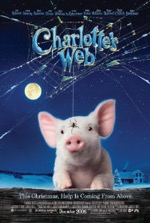
Starring: Dakota Fanning
December 2006
“Delightful Tale Affirms the Miracle of Friendship”
According to Greek mythology, King Midas could transform anything into gold simply by touching it. Precocious twelve-year old actress, Dakota Fanning can do the same with movies. Don’t believe it? Name one Fanning film that was a flop. It certainly isn’t her latest project, the wistfully dreamy live-action version of E.B. White’s classic children’s book, Charlotte’s Web.
In the movie Fanning plays Fern, a prepubescent powerhouse whose deep personal convictions drives her to defend a runty pig from being slaughtered. Raising the pig on her own, Fern names the undersized porker Wilbur (voiced with the perfect degree of childlike innocence by Minority Report’s Dominic Scott Kay). Fern and Wilbur are inseparable during the long, lazy summer months, but with the onset of fall, Fern is forced to sell the pig to the neighbors after an ill-fated attempt to conceal the pig in her school desk lands her in trouble with teacher and parents.
The neighbor’s barn is filled with talking animals whose personalities are as diverse and colorful as a rainbow. Separated from Fern, Wilbur tries making friends with his stall mates; the leader of three aimless sheep (John Cleese), two quarreling geese (Oprah Winfrey and Cedric the Entertainer), a pair of gossipy cows (Kathy Bates and Reba McEntire), two cowardly crows (Thomas Hayden Church and Andre Benjamin, who provide intermittent comic relief a la Skrit in Ice Age), a skittish horse (Robert Redford) and a selfish, hoarding rat named Templeton (Steve Buscemi), but none of the animals seem overly eager to make Wilbur’s acquaintance. In the throes of loneliness, Wilbur finally finds a friend; gracefully descending from a silken thread, the wise and compassionate arachnid, Charlotte, introduces herself to the pig. When the other animals taunt Wilbur, calling him a “future football,” Charlotte promises the innocent spring pig that he’ll live long enough to see winter’s first snow. How Charlotte and the other animals accomplish that feat is, as Paul Harvey would say, the rest of the story.
I’m ashamed to admit that I never read Charlotte’s Web as a youth and only remember snippets of the animated film released in 1973. Expecting something far more pedestrian, I was pleasantly surprised by a genuinely human story that reinforces the immutable virtues of friendship, courage and selflessness.
Fanning’s contribution to the film cannot be overstated, but equally vital are the pitch-perfect vocal deliveries by the entire cast, with highlights provided by Kay, Buscemi and Roberts. Roberts brings elegance and compassion to, arguably, the most loathed creature on the planet; Charlotte’s appeal is further enhanced by the CGI artists who make Charlotte’s face appear more sympathetic and less sinister than a real-world spider. Though Wilbur is the central character, the story is called Charlotte’s Web, and a large part of the movie’s success is due to Roberts’ affectionately soothing vocal performance that puts the spot in spot-on.
Charlotte’s Web is some movie; a delightful escape to a younger, simpler age, when summers were eternal and having adventures in a nearby wood was a full-time job. Director Gary Winick has paid faithful tribute to E.B. White’s book, while also delivering one fine piece of cinema. From the casting to the acting and from the talent in front of the camera to the wizards frantically working behind the scenes (especially on the breathtaking web-weaving sequences), every element of Charlotte’s Web is painstakingly and lovingly crafted...passion for the project and reverence for the source material is evident in every frame. This is one humble pig that deserves to take a bow.
Rating: 3
The Holiday (PG-13)
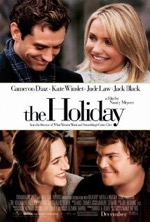
Starring: Kate Winslet
December 2006
“Emotionally Satisfying Rom-Com Delivers Seasonal Cheer”
Iris (Kate Winslet), a columnist living in England, gives her ex-boyfriend Jasper (Rufus Sewell) a present but he fails to reciprocate, barely acknowledging her existence at an office Christmas party. Though recently engaged to another woman, Jasper still professes his love for Iris. For obvious reasons, Jasper wants to keep Iris on the hook. Though she despises his philandering ways, Iris is utterly blind to her emotional dependence upon Jasper and holds on to a desperate hope of getting back together with him. Exasperated, Iris comes to the conclusion that she needs a break from her life.
Amanda (Cameron Diaz) is a self-assured movie trailer editor, who lives in L.A. After breaking up with her pigheaded boyfriend (Edward Burns), Amanda just wants to leave her troubles behind for a while. While searching for vacation destinations online, Amanda discovers a house swap option that gets her wheels turning. After an extensive IM conversation, Amanda and Iris agree to swap houses for the holidays.
If that oversimplified plot outline didn’t grab you, I urge you to disregard my Jack and Jill synopsis and give The Holiday a chance to warm your heart with its sincere performances, emotionally complex story and astounding direction by Nancy Meyers (The Parent Trap). Meyers is a master at gradually layering characters’ emotions which yield intense payoffs later in the film. She can even achieve such satisfying results with shallow characterizations such as Sewell’s unrepentant boor. Despite the occasional schmaltzy scene or line of dialog, the film is deeply moving in ways more subtle than obvious.
You would naturally and justifiably expect a lot out of a cast including Diaz, Winslet, Jack Black and Jude Law, and they all live up to their billing, especially Black, who turns in his most endearing performance as a movie composer…very few actors could’ve pulled off the “accidental boob graze” scene with as much charm. Additionally, the scene where Miles (Black) serenades Iris in a video store is an instant classic (keep an eye out for a Hollywood mega-star, who gets one of the biggest laughs in the film).
What puts it over the top for me is a subplot focusing on Iris’ serendipitous friendship with a retired motion picture screenwriter named Arthur Abbott (Eli Wallach). Abbott’s commentary on the current state of Hollywood, in light of its glorious past, is a fascinating aside that Meyers didn’t have to include, as it has very little bearing on the overall story. The fact that Meyers took the time to develop this storyline, along with all of the leading characters, is what differentiates this project from the run-of-the-mill rom-coms that seem to pop up like weeds at the Cineplex these days. Meyers’ screenplay has some meat, some meaning, along with healthy doses of comedy and romance.
Words sometimes fail when attempting to describe The Holiday because it’s a movie that has to be experienced, not merely discussed. There’s a lot of movie magic here, which hopefully will translate into generous box office. With instant name recognition and A-list headliners, here’s hoping The Holiday will be cherished as a seasonal favorite for many years to come. For those who appreciate intuitive direction, believable performances and organic writing, Christmas has come early this year.
Rating: 3 1/2
Deja Vu (PG-13)
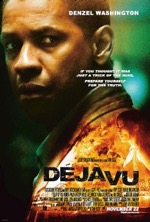
Starring: Denzel Washington
November 2006
“The Feeling That You’ve Seen This Plot Before”
In 2001, the Oscar for Best Actor went to Denzel Washington for his portrayal of a crooked cop in Training Day. With an Oscar in one hand and an ever-growing list of box-office hits in the other, one wonders why Denzel settled for the diverting, yet middling love story, Déjà Vu, which co-stars Val Kilmer, Jim Caviezel and the comely Paula Patton (Hitch).
The movie opens with a domestic terrorist attack on a ferryboat in a New Orleans harbor (hasn’t the city already suffered enough?). Detail-retentive ATF agent, Doug Carlin (Washington), responds to the disaster and takes on the challenge of solving the mystery surrounding the death of Claire (Patton), a young, attractive woman who washed up onshore two hours before the bombing with burn marks and chemical traces consistent with the other ferryboat victims. A visit to Claire’s house reveals even more time incongruities: Having never met Claire, Doug is startled when he plays back a voicemail message he left on Claire’s answer machine. Doug also discovers a cryptic admonition spelled out in alphabet magnets on Claire’s refrigerator door, “U can save her.”
The story takes a sci-fi twist when Agent Pryzwarra (Kilmer) invites Doug to join his special team of techno-geeks, who employ state-of-the-art technology to play back events from the recent past. At first, Doug is awed by the hi-tech equipment, but ongoing timeline discrepancies drive him toward disturbing revelations about Claire, whom he’s rapidly falling in love with, and his Geek Squad cronies.
The main bane of most time travel stories is a flawed or confusing paradox, and Déjà Vu, unfortunately, suffers the effects of this narrative nemesis. This Jerry Bruckheimer produced, Tony Scott directed film had all the potential to be a first-rate thriller, but it suffers from scientific inconsistencies and plot holes big enough to drive an ambulance through. From a dramatic standpoint, the movie’s elegant wrap-up is effective and maybe even a tad heartwarming, but the film leaves its audience with the nagging feeling that they’ve fallen victim to cinematic prestidigitation. Even with the Temporal Mechanics for Dummies seminar at the movie’s midpoint, the convoluted plot—which plays fast and loose with the very theories it espouses—fails to deliver the stand-and-applaud climax the writers were clearly anticipating.
The only groundbreaking concept in the movie is the scene where Doug tracks the killer to his hideout with the help of a goggle rig that transmits images from four days earlier, before the bombing took place. The high-speed pursuit—where Doug keeps one eye on the past and one eye on the road—is, arguably, the most memorable sequence in the film, but it’s all so much visual Teflon…hollow thrills that are quickly forgotten once the movie fades to black.
Washington does his usual good job as the unimpeachable agent and Caviezel plays an adequate cold-blooded killer, but both characters are severely underserved, particularly Caviezel’s Oerstadt. We witness Oerstadt’s bloodletting, but we don’t know anything about him or what motivates him to commit such heinous acts. Oerstadt, a washed-out military man, does issue one spine-tingling line however, “One man’s terrorist is another man’s patriot.” As for the other actors, Kilmer is mere set dressing and Patton does solid work in a limited role.
Déjà Vu would have been a runaway success if not for the muddy cause and effect plot which bogs down a story that otherwise would have been immensely enjoyable. It’s just too bad the writers couldn’t use the movie’s technology to go back in time and fix some of their mistakes…and fix some of their mistakes.
Rating: 2 1/2
Deck the Halls (PG)

Starring: Matthew Broderick
November 2006
“Fa, la, la, la, la…ha, ha, ha, ha!”
Holiday movies focusing on feuding families/neighbors are a dime a dozen and are generally worth about the same amount. These films usually fall into one of two categories: 1. Neighbors attempt to outdo each other in decorating their houses, or 2. Visiting relatives disrupt the status quo, putting family members at each other’s throats until someone shouts above the din and reminds everyone about the true meaning of Christmas. Although Deck the Halls, starring Danny DeVito and Matthew Broderick, has elements of both scenarios, the movie contains just enough originality to break free from the cookie-cutter rigidity of such Holiday rejects as Jingle All the Way and the Home Alone sequels.
Steve Finch (Broderick), a mild-mannered optometrist, is the Winter Fest coordinator and is known about town as “Mr. Christmas.” His title and reputation are immediately challenged when Buddy Hall (DeVito) makes a late night move into the house across the street (“Who moves in the middle of the night,” Steve asks his barely conscious wife, “a meth lab?”). Buddy, a struggling car salesman who rapidly looses interest in any new experience, has fallen into the pattern of moving from place to place, job to job and obsession to obsession. Despite Buddy’s repeated attempts at finding a lasting happiness, fulfillment in life continues to elude him. Buddy confesses to his wife that he’s always wanted to “do something big…something monumental.” Buddy’s impetus comes when his two Barbie doll daughters introduce him to a computer program that can pinpoint every house on the planet from space…every house, of course, except for theirs. Buddy’s new ambition is to make his house bright enough to be seen from outer space.
Threatened by Buddy’s instant popularity (people are coming from miles around to see Buddy’s extravagant light show), Steve does everything in his power to prevent Buddy from seeing his dream come to fruition, including sabotaging Buddy’s display by throwing a snowball at the exterior circuit panel. However, Steve fails to account for Buddy’s backup generator, which kicks in a short time later and brings the thousands of scintillating light bulbs back to life. When Buddy discovers Steve’s perfectly placed snowball and when Steve discovers that Buddy has been stealing power from his house, the gloves come off and both men engage in a war of subversion and chicanery. Fed up with Steve and Buddy’s petty rivalry, Steve’s wife Kelly (Kristin Davis) and Buddy’s wife Tia (Kristin Chenoweth) both pack up and head for a hotel. Faced with a life-altering decision, Steve and Buddy must either choose to sober up and make amends or continue with their childish quarreling and risk loosing everything they hold dear.
A cursory character study reveals Steve as a tradition-bound stiff who just wants peace and quiet, and Buddy as a conniving, obnoxious glory-hog who just wants to be noticed. Together, the characters, and the actors who portray them, create a unique brand of contentiousness that recalls, but certainly doesn’t supersede, Matthau and Lemmon’s incisive bickering in such movies as Grumpy Old Men. The leads have excellent chemistry together; DeVito is his usual zany self, but Broderick’s dead-pan delivery is sidesplittingly hilarious. Both Kristin’s do excellent work as the disgruntled wives, and I’m gratified that director, John Whitesell, put Chenoweth’s considerable vocal talents to good use on “Oh, Holy Night.”
Though it’s not as humorous as A Christmas Story or as heart-warming as Miracle on 34th Street, Deck the Halls is a diverting popcorn flick and is a worthy entry into the vast catalog of feel-good Holiday treats. With this, yet another film that was named after a Christmas song, one wonders when we’ll see the movie version of “Grandma Got Run Over by a Reindeer.”
Rating: 2
Happy Feet (PG)
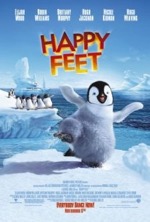
Starring: Elijah Wood
November 2006
“Heavy-Handed Politics Leaves ‘Feet’ Flatfooted”
The last time I saw an animated movie this political was FernGully: The Last Rainforest (1992). An indoctrination session for the New Age movement, the movie extols the mystical energies that govern the “circle of life,” while vilifying the humans responsible for deforestation and upsetting nature’s delicate balance. On the face of it, Happy Feet is a seemingly innocent, completely innocuous animated film, whose only apparent pretension is that it comes too soon on the heels of 2005’s surprise hit documentary, March of the Penguins—but as we all know, appearances can be deceiving. For anyone who’s seen March of the Penguins, the opening chapter of Happy Feet will feel like a prolonged bought of déjà vu, complete with plagiarized narrations and scenes that look like they were lifted right out of the documentary.
Early on, the movie focuses on Mumble’s (Elijah Wood) desperate attempts to fit in with his peers; Mumble can tap-dance like Fred Astaire, but his singing resembles a blaring foghorn. One adult penguin, who looks down on the misfit youth, charges, “A penguin without a heart song is no penguin at all.” Excluded from many normal activities—much like that famous reindeer we’ve all sung about—Mumble often steals away to a nearby glacier and tap-dances by himself, away from disapproving eyes.
Somewhere along the way, the movie’s depiction of an outsider with abnormal development becomes a thinly veiled reference to homosexuality. The scene where this becomes painfully obvious is when Mumble teaches his peers how to tap-dance; the old guard vehemently opposes the new form of artistry, viewing it as an uprising, an aberration and a pagan display. When Mumble’s father implores his son to desist with his peculiar dancing, Mumble replies, “Don’t ask me to change, pa’, because I can’t.” With that, Mumble is banished from the penguin community.
A short time later, mumble is befriended by a quintet of diminutive, Latin-speaking penguins; awed by Mumble’s skillful dancing they welcome him into their group with open flippers. (As a pertinent aside, George Lucas was widely criticized for creating aliens with Asian accents in Star Wars: Episode I, but in Happy Feet, where ethnic speech stands out like Mumble’s blue eyes, no one, especially the liberal left—to whom the film heavily panders, has said a word about the obvious racial stereotyping.) Mumble and the Latin penguin entourage team up with Lovelace (Robin Williams), a kind of charismatic prophet who wears a plastic six-pack holder as a necklace.
As the ragtag group goes in search of “aliens”—the mysterious beings who gave Lovelace his necklace—they soon discover huge warehouses, docks, heavy equipment and colossal fishing boats. It’s at this point when humans are revealed as not only the aliens, but also as the villains of the movie; apparently humans have been stealing scores of fish from local waters and leaving the penguins with empty stomachs. Captured and imprisoned in an arctic exhibit, Mumble makes repeated attempts at communicating with his human captors, but his animal vocalizations fall on uncomprehending ears, “Why are you taking our fish? You’re kind of killing us out there!”
In order to keep from going crazy, Mumble learns to entertain spectators with his fancy footwork, which immediately draws the attention of the scientific community. Mumble is implanted with a tracking device and released from captivity: A film crew follows Mumble back to his home and captures footage of the penguins dancing in Mumble’s soulful style. Once assembled and released, the documentary creates a political and public outcry which leads to a moratorium being placed on fishing in the waters near Mumble’s glacier. The movie’s final shot tracks a penguin feather as it’s carried along by the wind in a gliding, meandering course, much like Robert Zemeckis’ free-flowing feather at the conclusion of Forrest Gump. Coincidence? I don’t think so!
Where Forrest Gump is existential, Happy Feet is environmental. In fact, the movie’s political slant is so transparent and so in-your-face, it’s almost nauseating. How cowardly of leftist Hollywood and environmentalist wackos to use an animated film to espouse, disseminate and otherwise foist their alarmist and fear-mongering doctrine upon audiences; offending many adults and unduly influencing the minds of future generations with a “green” theology.
The localized and oversimplified climax is utterly laughable…one dancing penguin can save the planet? One colony of dancing penguins can change international policy? I’m sure even older children can discern that they’re being sold a load of penguin droppings. And it’s really children who are loosing out the most here; for their sake, why can’t Hollywood check its politics at the door and let kids make up their own minds about where they stand on environmental issues…when they’re old enough to do so?
The real tragedy with Happy Feet is that, politics aside, the film is a visual marvel—the next evolutionary leap in CGI. The leopard seal chase is an exhilarating thrill ride of evasive maneuvers and narrow escapes and the killer whale sequences are absolutely breathtaking. Also, the movie’s vocal talents are stellar, though it seems as if every other character is voiced by Robin Williams, and that gets a tad tedious.
Happy Feet would’ve been so much better had it simply concentrated on being an animated kid’s film and not on being a stilted soapbox lecture on global correctness; the heavy-handed sermonizing severely detracts from what otherwise would have been a highly entertaining family film. So, as Mumble would say, I appeal to Hollywood’s better nature and officially request that they refrain from producing films, especially animated ones, which are nothing more than a political platform for some special interest group to use in propagating their misguided message to a mass audience. Just as there’s a separation of church and state, I propose a separation of politics and media. It probably would never work, but what the heck, we might just get objective news out of the deal.
Rating: 2
Casino Royale (PG-13)
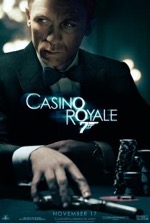
Starring: Daniel Craig
November 2006
“High Stakes Bond With a Rising Star”
From the first frame of the opening sequence—a brilliant, casino-themed montage where guns shoot spades, featureless victims bleed small red hearts and a person falling to his death shatters into a pile of cards upon impact—it’s clear that this isn’t your father’s Bond movie. Incidentally, this is also the first Bond film in memory that doesn’t showcase silhouetted naked women in the opener. The firsts don’t stop there; Casino Royale, based on the novel of the same name by Ian Fleming, chronologically predates all of the previous Bond films, making it a prequel of sorts. As such, we are retrospectively introduced to some Bond’s most recognizable touchstones; we discover how Bond comes to own his Aston Martin, learn how he creates the phrase, “shaken, not stirred,” and witness his first utterance of that iconic line, “Bond, James Bond.”
When Daniel Craig (Layer Cake) was confirmed as the new Bond, I was more than just a little skeptical; however, my misgivings were wholly unfounded. With all due respect to Connery and the rest of the gang, Craig, pound for pound, might just be the best Bond ever. He’s certainly more ripped than any former 007, judging from the scene where Bond emerges from the ocean with a premium six-pack—a tableau that parallels Halle Berry’s entrance in Die Another Day. Where Pierce Brosnan’s Bond would have quipped, finessed or negotiated his way out of a fight, Craig’s Bond bulldozes anyone who poses a threat to him. As such, the new Bond is scrappier than his predecessors and takes the quickest route to dispatching his enemies a la 24’s Jack Bauer. What’s refreshing—for an action hero archetype—is that this Bond occasionally makes mistakes (like when he gives himself up by clumsily tailing a bad guy), albeit, not fatal ones.
The stunt work, fight scenes and action sequences in Casino Royale are some of the finest in the entire series and are certainly above par when compared to your garden variety action picture. Some of the movie’s best action scenes include an explosive car chase at Miami International Airport, an all-out, hand-to-hand slugfest in a hotel stairwell and a frenetic shootout inside a pontoon-fortified Venetian building. However, all of those scenes pale in comparison to the opening, skyscraper scaffolding sequence in Madagascar where Bond pursues a bomb-toting, free running terrorist who scales walls like Spider-Man and bounces over and around obstacles like a monkey on speed. The scene easily qualifies as the finest action sequence I’ve ever seen…if it fails to get your heart racing, you have no pulse.
For poker lovers, roughly a quarter of the movie focuses on a high stakes Texas hold ‘em tournament in Montenegro. However, even if you don’t know the difference between a straight and a flush (or a straight flush), you’ll still enjoy the psychological warfare employed by the players along with the refined trash talking that randomly bounces around the table like a pinball. Here’s the scenario: If Bond wins, he will financially cripple an international terrorist organization…if he looses, Her Majesty will have just funded said terrorist group.
For female viewers, the movie also features a friction-filled romance between Bond and hard-to-get Vesper Lynd (Eva Green), an accountant sent to keep an eye on Bond and distract the other players with her slender frame, dangerous curves and bedazzling red dress. There’s a wonderful scene where Bond and Vesper engage in a war of words on a train bound for Montenegro. Fraught with sexual tension, double entendres and some of the best repartee I’ve heard since Cary Grant and Eva Marie Saint patented the lascivious train ride in Hitchcock’s classic North by Northwest, the scene kicks the romance subplot into high gear, and sets the stage for the twisty and tragic climax.
What makes this Bond superior to its forebears is the sure-handed directing by Martin Campbell and the superlative script penned by Academy-award winning screenwriter, Paul Haggis (Million Dollar Baby). The movie has great supporting characters including Judi Dench, who reprises her role as M and Mads Mikkelsen as a heartless villain, Le Chiffre, a man who bleeds from his blind right eye when angered.
Casino Royale is the best Bond to date, and not just because of its up-to-date FX or its new star; this is a more modern and mature Bond, unshackled by the usual silliness involving hi-tech gadgets and gizmos. With a film this superior, odds are we’ll be seeing Bond…Craig’s Bond again very soon.
Rating: 3
The Santa Clause 3: The Escape Clause (G)
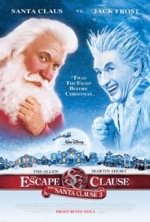
Starring: Tim Allen
November 2006
“Third Time Isn’t the Charm for This Freezer Burned Sequel”
I didn’t much care for The Santa Clause, starring Tim Allen, and skipped the sequel on purpose. I was willing to give this new film, entitled The Santa Clause 3: The Escape Clause, a fair shake, mostly because of Martin Short’s inclusion in the cast. Going in with a reasonably open mind, I was sorely disappointed in a comedy that not only lacked humor, but also featured an insufferably childish storyline.
As the movie opens, we learn that Scott Calvin/Santa’s (Allen) wife, Carol Calvin/Mrs. Clause (Elizabeth Mitchell), is pregnant. Carol wants her family by her side during the delivery, but the Clause’s can’t exactly reveal their true identities or the secret location of the North Pole. Someone (probably that chunky Spencer Breslin kid who seems to find his way into every Tim Allen movie these days) comes up with the idea of passing off the North Pole as a Canadian village simply by changing the signage and closing off top-secret areas. The Sandman (Michael Dorn) puts Santa’s in-laws, Bud (Alan Arkin) and Sylvia (Ann-Margret), to sleep and Santa ferries them to “Canada” in his renowned sleigh.
Meanwhile, Jack Frost (Short) is brought before the Council of Legendary Figures and is sentenced to manual labor in Santa’s workshop for his crimes (not legendary for their wisdom, it would seem): predictably, Frost wastes no time in sabotaging the factory. Frost’s end game is to steal Santa’s special snow globe and trick him into saying, “I wish I wasn’t Santa,” which is the extent of the Escape Clause. After accomplishing his task, Frost grabs Santa’s coat and becomes the new Santa. Before you can say “Blitzen” Frost converts the North Pole into a Vegas-style resort where myriad vacationers swarm to shops, shows and restaurants, fighting over merchandise and steamrolling anyone who gets in their way. Scott, the deposed Santa, must beat Frost at his own game to retain the mantle of Santa and restore Christmas to its former glory.
This was the point in the film where I actually felt like it had the potential to go somewhere, but almost before the problem is presented, it’s elegantly resolved by a plan the audience can see coming a mile away: Scott’s telegraphed solution is packaged, wrapped and tied up with a pretty little bow. How convenient. How contrived.
As poor as the script is, the movie’s biggest tragedy is how such a decorated cast could be relegated to acting in such pedestrian fare. However, if there’s one aspect of the movie that shines like Rudolph’s nose, it’s the highly creative, finely-detailed set pieces that festoon the various incarnations of the North Pole. In many ways, the sets are reminiscent of those crafted for Dr. Seuss’ How the Grinch Stole Christmas, sans Seuss’ skewed visual style.
Disney forbid there should be a Santa Clause 4, but if another sequel should slide down the Hollywood chimney in the near future, one can only hope that the script shows a marked improvement over the one presented here—that would be the best gift of all.
Rating: 1 1/2
Flushed Away (PG)
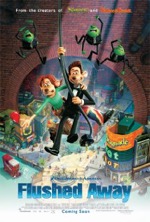
Starring: Hugh Jackman
November 2006
“Take the Plunge…It’s Tons of Fun”
From Aardman Animations (producers of Chicken Run and Wallace and Gromit in The Curse of the Were-Rabbit) and DreamWorks Studios comes Flushed Away, a high-spirited romp that transports spectators from London’s upper-crust suburbs to its slug-infested sewers. A modern twist on The Prince and the Pauper, Flushed Away features jaw-dropping animation (this is the studio’s first entirely CG film) and upholds the tradition of excellence established in Aardman’s finely crafted Claymation films.
As a well-mannered, well-cultured and well-groomed house rat, Roddy (Hugh Jackman) has it all; he can cruise around in a R.C. car with a beautiful blonde doll, play a one-sided tennis match with inanimate players and create imaginary conversations with action figures in a play set café. As a pampered pet in an uptown flat, Roddy has the freedom to do whatever he wants, but his existence is a shallow one because there’s no one with whom he can share his staged and synthetic adventures. Capping off another hollow day, Roddy tucks himself into a dollhouse bed and wonders what it would be like to have a real family and friends. As loneliness consumes him, Roddy hears a noise down the hall and gets up to investigate; he discovers Sid (Shane Richie), an obese, ill-mannered sewer rat who makes himself at home in Roddy’s immaculate penthouse apartment. Roddy’s attempt at tricking street-smart Sid into returning to the sewer backfires when Sid shoves Roddy into the “jacuzzi” and pulls the lever.
When Roddy hits the bottom, he discovers a whole new world, but it’s nothing like the one Jasmine sings about in Aladdin; prim and proper Roddy gets a taste of how the other half live when he enters a sludge-filled sewer. Roddy soon stumbles into a subterranean city, dubbed Ratropolice, which is managed and inhabited entirely by sewer rats. As he embarks on a homeward journey, Roddy encounters Rita (Kate Winslet), captain of the scavenger vessel Jammy Dodger and the rat-loathing villain named The Toad (Sir Ian McKellen). Before he can return to the comfortable, sanitary, yet lonely environs of his owner’s mansion, Roddy must survive hair-raising pursuits through sewer passageways, evade Le Frog (Jean Reno), the French assassin and his ninja frog cronies, and foil The Toad’s plans to turn Ratropolice into a giant deep freeze.
Each of these Aardman movies has a “pandemonium sequence” (PS), which usually kicks in toward the end when forces collide and the action is ratcheted up to breakneck pace. In Chicken Run, the PS comes when the collective fowl desperately try to lift-off in their makeshift plane, and in Wallace and Gromit, the PS occurs when the true identity of the Were-Rabbit is revealed and everyone tries to capture him/it. Though Roddy and Rita’s climactic showdown with The Toad and his two rodent lackeys (Bill Nighy and Andy Serkis, who deliver pitch-perfect vocal performances) is exciting, the action never quite approaches the heights of frantic insanity achieved during the pandemonium sequences in those other two Aardman films.
Despite the tepid climax, there are some great moments in the movie, like Roddy’s introduction to Rita’s Brady-Bunch-on-speed family at their shifty, wave-tossed house or the high-speed chase where French frogs pursue the Dodger on cake mixers, or the intermittent comic relief provided by the show-stealing, serenading sewer slugs? Though it tells a touching tale about the necessity of friendship, the movie is noticeably more remedial than Aardman’s previous efforts; however, since the movie’s target audience is kids, that’s not such a bad thing and there are plenty of elements in the film that adults will enjoy as well. In the end, the movie is heartwarming and highly entertaining, but not necessarily award winning. Some may smell a rat here, but I still maintain that Flushed Away is a family friendly, fun-filled caper that should give us all a newfound respect for sewer workers.
Rating: 2 1/2
The Prestige (PG-13)
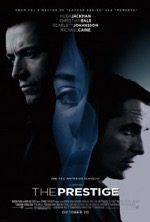
Starring: Christian Bale
October 2006
“Are You Watching Closely? You’ve Been Tricked!”
Director Christopher Nolan and actors Christian Bale and Michael Caine were driving forces behind last year’s critically acclaimed, comic book-to-big screen action thriller, Batman Begins. Add to that team X-Men’s Wolverine, Hugh Jackman, and the sultry siren, Scarlett Johansson and you have a surefire hit on your hands…right?
As would be expected, the film opens with a magic show. The magician is assisted by Cutter (Caine) backstage and Robert (Jackman) and Alfred (Bale) who are planted in the audience and selected every night as part of the performance. Robert and Alfred are aspiring magicians, but their association as friends and colleagues abruptly ends when Robert’s wife, Julia (Piper Perabo), drowns in a water tank during an illusion gone wrong. Robert casts blame on Alfred, who always tires to push a trick to the next level and takes unnecessary risks. The balance of the movie deals with Robert’s repeated attempts to avenge his wife’s death, while trying to beat Alfred at his own game.
The game of one-upmanship between the two competing magicians is engaging at first, but the point and counterpoint plot exponentially looses steam as the movie progresses. The movie’s climax is like a chess skirmish where both players trade pieces until one player takes a piece and his opponent can’t counter, producing a clear-cut victor. Trying to figure out who will outthink his rival and deal the ultimate deathblow was clearly intended to be an enjoyable experience, but the volleying storyline, in the end, is more exhausting than exhilarating.
These disparaging comments are in no way an indictment against the director, actors or anyone else involved in the movie’s creative or technical departments, all of whom did an exceptional job of transporting the viewer into this turn-of-the-century period piece. If any area of the movie bears criticism, it’s the prefab plot based on Christopher Priest’s novel. Every magic trick is based on diversion and deception, and the storyline here deals in the same kind of chicanery—the plot is a façade that appears to be an intricately woven yarn, but is simply a hollow attempt at generating Industrial-era intrigue; wowing audiences with its all-star cast, the movie only offers cheap thrills and unfulfilled promises.
At the movie’s midpoint, Robert seeks out eccentric inventor, Nikolas Tesla (David Bowie, in a brilliant piece of surprise casting), who builds Robert a machine that is way beyond today’s technology, much less that of a century ago. As egregious as that is, the final nail in the movie’s coffin is protagonist confusion. Just who are we supposed to root for here? True, the magicians demonstrate their genius over the course of the film, but both men are so riddled with foibles, ranging from self-aggrandizement to an overactive need for vengeance, so as to be flawed beyond recognition as heroes. The person I wanted to come out on top suffers ultimate defeat, but who cares? There’s nothing virtuous about either magician and in the end, it doesn’t really matter who you pull for, they’re both egomaniacs who stop a nothing to produce better illusions than their opponent and, therefore, are utterly despicable. Did screenwriters Jonathan and Christopher Nolan fail to realize that the audience would naturally want to choose sides and that every story must include at least one hero that everyone can cheer for?
I so badly wanted this film to succeed, but alas, the movie falls for its own sleight of hand. If, like me, The Prestige left you wanting more, check out the other recent magician movie, The Illusionist, starring Edward Norton. Unlike The Prestige, The Illusionist doesn’t waste its or your time on competitive shenanigans or scientifically impossible illusions…there’s nothing hidden up its sleeve.
Rating: 2 1/2
The Guardian (PG-13)
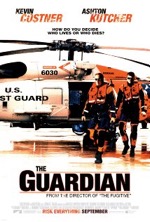
Starring: Kevin Costner
September 2006
“Standard Ending Nearly Sinks Heartfelt Story”
“It was the best of times, it was the worst of times…” Dickens’ oft-quoted line from his classic A Tale of Two Cities is an excellent description of the latest Kevin Costner vehicle entitled The Guardian. An obvious promotional piece for the Coast Guard—its riff on Top Gun—The Guardian boasts several meaningful scenes, but also contains some elements that are in desperate need of being rescued.
Ben Randall (Costner), a legendary Coast Guard rescue swimmer, was recently traumatized when a rescue mission ended in tragedy, leaving him the only survivor. The mental toll of the ill-fated rescue attempt, compounded with Ben’s recent separation from wife Helen (Sela Ward), forces Capt. Hadley (Clancy Brown) to take Ben off of active duty; Ben is transferred from Barksdale AFB in Kodiak, AK to the Coast Guard training facility in Louisiana. Inspecting the new crop of trainees, Ben sees potential in cocky upstart, Jake Fischer (Ashton Kutcher); a decorated college swimmer, Jake has his sights set on toppling all of Ben’s swimming records. However, as Ben is quick to remind the trainees, there’s more to saving lives than just swimming. Scrapping the traditional PT regimen, Ben initiates a series of unorthodox training sessions; including a one hour endurance test where touching the bottom or sides of the pool means instant disqualification from the program, a hypothermia exercise in an ice-filled pool and a teamwork/breathing exercise where two swimmers must move a brick from one side of the pool to the other, but the swimmers can only come up for air one at a time. Ben’s hard-nosed approach immediately alienates Skinner (Neal McDonough) and makes Capt. Frank Larson (John Heard) wonder if Ben’s cut out to be a drill instructor. These training sequences are the movie’s double-edged sword—some viewers will enjoy the process involved in molding trainees, while others will grow frustrated by the lack of progression and check out somewhere in the middle of the movie.
The film’s structure is basic enough; the beginning and end feature rescue missions, while the middle focuses on academy training. Besides being predictable at every turn, The Guardian defaults to the standard disaster movie ending where the older man cuts himself free from a safety cord so that the younger man can continue on and, presumably, live a long and fruitful life. We’ve seen this exact ending in Backdraft and Vertical Limit, with Armageddon and Poseidon bearing a close enough resemblance to make it worth mentioning here. This climax must be effective—even though it shamelessly manipulates the audience’s emotions—otherwise it wouldn’t be used with such frequency. But please, Hollywood movers and shakers, no more resolutions of this kind! Next time, maybe the writers can do something different and sacrifice the younger man—it might be politically incorrect, but at least it would contain a modicum of reality and treat the audience to something original.
That is not to say that the movie doesn’t have any touching moments: Ben’s apparent reconciliation with his wife makes his tragic demise all the more painful. Also, when Ben and Jake learn that they both have emotional hang-ups over being the sole survivor of an accident, a connection is made and a friendship begins to form. These episodes, where genuine emotions begin rising to the surface, are few and far between in a movie far more concerned with magnifying the courageous sacrifice of Coast Guard swimmers, as honorable as that is, than with chiseling out three-dimensional characters or crafting dialogue written above a high school level.
As for the acting, Costner is a tad less wooden here than usual, and Kutcher shows early signs of being a decent dramatic actor. What anchors the movie is its excellent supporting cast; especially Heard, McDonough, Ward, Brown and Melissa Sagemiller as Jake’s girlfriend, Emily.
Though some of the sequences involving angry, undulating waves made me seasick, like the ones in The Perfect Storm, director Andrew Davis (The Fugitive) does a good job of making the action seem realistic. Too bad the script didn’t follow suit.
Rating: 2 1/2
The Illusionist (PG-13)
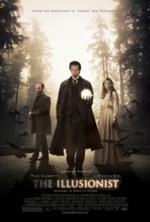
Starring: Edward Norton
September 2006
“Like Lucky Charms, It’s Magically Delicious”
As I started jotting down notes at a screening of The Illusionist, my pen abruptly died. After exhausting every conceivable strategy of coaxing ink out of the depleted stylus, I settled on an alternate note-taking strategy. I wrote my observations with a firm hand and later retrieved them by rubbing pencil lead over the page, which revealed the text in reverse. When I started writing this review, it suddenly occurred to me that such basic science might be commonplace to you and me, but to a five-year old child it might appear as…magic!
The magic performed by Eisenheim the Illusionist (Edward Norton), however, is a tad more sophisticated than my pencil-rubbing trick. It is said that, as a boy, Eisenheim was inspired by a traveling magician who showed the lad a few illusions before disappearing into thin air. Magic consumed the Eisenheim during his formative years, but his focus expanded the day he encountered the beautiful duchess, Sophie. Despite their disparity in social standing, Eisenheim and Sophie were inseparable growing up; “One day we’ll run away together,” she promised.
As an adult, Eisenheim plies his trade as an illusionist in small, but packed theaters in Vienna, garnering the esteem of many prominent patrons, including the inquisitive Chief Inspector Uhl (Paul Giamatti). During that fateful performance, the magician asks for a volunteer, and, much to his surprise, Eisenheim is reunited with his childhood sweetheart when she glides onto the stage. After the show, Eisenheim learns that Sophie (Jessica Biel) will soon be engaged to Leopold (Rufus Sewell), the crown prince. Sensing the potential threat posed by Eisenheim, Leopold orders Uhl to “shut him down” (surely a common phrase during that period). With Uhl watching his every move and Leopold seeking his life, Eisenheim creates a new show that must confound the audience, foil Leopold’s plans and win back Sophie’s heart before it’s too late.
As the movie’s slogan suggests, “Nothing is what it seems.” This is certainly true as the movie never reveals its hand until the very last scene. Based on a short story by Steven Millhauser entitled “Eisenheim the Illusionist,” writer/director Neil Burger does an excellent job of managing this gothic tale, which certainly would have floundered in the hands of someone less visionary. The costuming, makeup and historic props and sets all exude authenticity and Burger’s use of a sepia-hued palette, aged film stock effects and old-fashioned circle wipes is extremely effective. Also, the revelation scene—where Uhl mentally deconstructs Eisenheim’s ultimate illusion in a montage of shots—is a brilliant way to illustrate the Chief Inspector’s flow of deductive reasoning.
Norton (The Italian Job) is a bit subdued here, but plays the part of Eisenheim with deftness equal to the skilled magician. Impressively, Norton did most of his own tricks in the movie (with the assistance of magician David Blaine), and what’s more, very few of the movie’s illusions received a CG touch-up.
Biel and Sewell (A Knight’s Tale) work fine as an improbable couple and their performances, as secondary characters, properly garnish the juicy ménage trios subplot—Biel soars here, leaving behind her 7th Heaven chrysalis. Though all of the actors shine, Giamatti’s performance stands out like a lighthouse beacon on a stormy night. Giamatti’s range is awe-inspiring; I’m thoroughly convinced that if someone put a white, fluffy wig on the actor’s head and said, “Be a Q-Tip,” he would not only pull it off but add unexpected nuance to the part. For The Illusionist, Giamatti adopts a European accent and a resonant baritone; he speaks softly, but with authority. Sporting a full beard and slicked back hair, viewers may fail to recognize Giamatti at first glance. Whereas Norton is the film’s heart and soul, Giamatti is its conscience and backbone…the versatile character actor has turned in yet another memorable performance.
Due to the constraining nature of a period piece featuring a magician, the movie, though entertaining and thought-provoking, is far from Best Picture caliber. However, the movie does boast one of the most satisfying twist endings to come along in quite some time. Anchored by a superior cast, The Illusionist juggles character development with breathtaking cinematography and an intricate plot that contains just the right amount of romance, political intrigue and brow-furrowing mystery. Now that’s a trick!
Rating: 3
Invincible (PG)
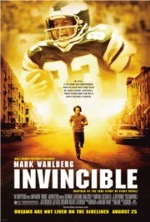
Starring: Mark Wahlberg
August 2006
“Wahlberg Flies Like an Eagle in Inspirational Gridiron Tale”
“Never tell me the odds!” That’s what Harrison Ford’s Han Solo told statistic-spewing robot, C-3PO, in The Empire Strikes Back. I wonder what the odds would be against a thirty-year old Average Joe earning a walk-on spot with an NFL team having only played one year of high school football. Whatever the odds, Vince Papale, a struggling Philly bartender, beat them in 1976 when he achieved the impossible and became a Philadelphia Eagle.
In the movie, Papale is played by Mark Wahlberg, who resembles the physical proportions—if not facial features—of the genuine article. Wahlberg’s performance is efficient, but certainly isn’t flashy; this also seems to mirror the real Papale, who originally was reticent to try out for the team and shied away from media attention…many reporters were all too eager to cover his miracle story.
As the movie opens, Papale is at his lowest point; his wife just walked out on him and his employment as a substitute teacher was recently terminated. New Eagles coach, Dick Vermeil (played with gridiron precision by Greg Kinnear…a touchdown for the casting department), makes an announcement that the Eagles will hold open tryouts at Veteran’s Stadium that Saturday. Vermeil’s pronouncement may have been viewed as a media stunt, but his real strategy was to shake up the entire Eagles organization—which had grown accustomed to loosing—and wake up a city that had fallen into a mental rut concerning their hometown team.
Though Papale’s friends encourage him to try out for the team, his father has a different opinion, “Let this one go; a man can only take so much failure.” Ignoring his father’s advice, Papale finds the nerve to try out, and of the thousands of Eagle wannabes that converge upon the stadium, Papale is the only person asked back to Eagle’s training camp. Spurred on by his dream to play professional football and by his ex-wife’s acerbic departure note (which basically says he’ll never amount to anything), Papale gives it his all during a tumultuous training camp and preseason, and anyone who’s familiar with the story, or who’s seen the trailer, can connect the dots from here. There’s no major twist here; history has already taken away any possibility of a surprise ending.
In the grand tradition of feel-good sports films like Rudy and The Rookie (whose producers also worked on this film), Invincible carries the “follow-your-dreams” torch with pride and excellence. Though the film’s through line is as straight as a Bradshaw spiral, there are several character-defining subplots that flesh out the movie and broaden our knowledge of the protagonist; such as the Cheers-like moments in the bar, the back lot football games and the arrival of Papale’s new love interest, Janet (Elizabeth Banks), who happens to be a die-hard fan of the rival NY Giants.
From the sets and costumes to the shaggy coifs, every aspect of the movie appropriately fits the period in which it was filmed; the 70’s soundtrack also adds an extra degree of authenticity. And speaking of authenticity, the inclusion of actual game footage, featuring some of Papale’s highlight plays, is a really nice touch.
Invincible is pure, unadulterated inspiration; a poignant reminder to us all that no matter who you are or where you’re from, as long as you have a dream and are willing to contend for it, miracles can happen. This is one of the best films of the year!
Rating: 3
Lady in the Water (PG-13)

Starring: Paul Giamatti
July 2006
“Shyamalan’s Scary Tale Succeeds by Taking Risks”
The word “narf” effortlessly plopped out of director M. Night Shyamalan’s mouth one evening as he was telling his children a bedtime story. That homespun fairytale soon became the creative fodder for Shyamalan’s latest thrill-fest, Lady in the Water. From the start, Shyamalan made it clear that the movie—an unconventional love story filled with mythological creatures—would be a radical departure from his other films.
The opening narration, conveyed in a series of petroglyphs, provides the particulars of the movie’s myth: Once every eon, an ancient race of humans send an envoy from their water world to meet with their surface-dwelling brethren in an attempt to ignite a great awakening among humans. A water nymph (narf) must find the “vessel”—a person of unique vision—that will usher in the era of peace. Despite repeated attempts throughout history, every narf ambassador has failed in her peace-fostering mission because “man doesn’t listen very well.”
As the story opens, we’re introduced to Cleveland Heep (Paul Giamatti), a tortured soul who manages an apartment complex in Philly. Cleveland’s mundane existence as handyman, exterminator and peacekeeper brings him into contact with many of the building’s colorful tenants, including the Hispanic couple and their five daughters, the Asian college student and her controlling mother, the Indian writer (Shyamalan) and his nagging sister, the eccentric jock who only exercises the right side of his body, the African American father who excels at crossword puzzles and his insightful son, the quartet of freethinking beer buddies and the newest tenant, a haughty movie critic.
It takes a while for Shyamalan to establish all of his characters and their relationships to each other, but when Story the narf (Bryce Dallas Howard) surfaces in Cleveland’s pool, the plot kicks into high gear and a first-rate mystery begins to unfold. Story quickly identifies the “vessel,” but determining the supporting players—the guild, the guardian and the symbolist—proves more problematic. Cleveland and his tenants, now bound by a common purpose, must protect Story from an aggressive, wolf-like creature called a skrunt until the giant eagle swoops down and carries her to freedom.
It all sounds a bit hokey on paper, but Shyamalan does a masterful job of balancing character and plot with the fantastical. In an effort to mitigate the moments of stark terror (which are far fewer and less severe here than in his other movies), Shyamalan has employed more humor this time, which is just a natural byproduct of the multi-layered and multi-cultural characters that populate his story. One of the ongoing sources of amusement is the Asian mother’s reticence to share the narf’s origin tale with Cleveland. At one point, Cleveland must act like a child and have milk and cookies on the woman’s couch in order to receive a short lesson in narf mythology. The arrogant critic also provides unexpected comic relief; his jaded commentary on romance movies and his miscalculation of the danger he’s in at the movie’s climax is highly entertaining.
There’s no doubt that Shyamalan can select stars (like Willis and Gibson) for his projects, but here he’s handpicked an amazing cast, each of whom shines in his or her own way and serves a different function in the director’s visionary yarn. Howard’s fair complexion and ethereal visage lends itself perfectly to the otherworldly Story. The fact that Story doesn’t know a lot about what’s going on makes the movie that much more riveting and satisfying. Giamatti works magic in the title role; his stuttering everyman is extremely likable and accessible—there’s something in his timbre and delivery that reminds me of a younger Richard Dreyfuss. As a reluctant leader, carrying around a Santa-sized sack of guilt from his wife’s death, Cleveland finds a measure of heroism within himself when his paternal instinct kicks in and drives him to protect Story at all costs. Cleveland is captivating throughout and is an excellent character study.
Some, undoubtedly, will find Shyamalan’s avant-garde resolution unpalatable; but you can hardly fault him for breaking with the “big twist ending” motif that’s marked all of his other films. Here, he tries something different, and, for better or worse, I applaud his efforts. Though Lady in the Water is far inferior to The Sixth Sense, it’s the most human Shyamalan tale to date—by assembling an excellent ensemble of intriguing characters, the auteur has delivered one of the most unique and refreshing movies to come along in quite some time. So, whether or not you buy into narfs and skrunts, know that Lady in the Water has inaugurated a new film genre…high-art fairytale.
Rating: 3
Pirates of the Caribbean: Dead Man’s Chest (PG-13)
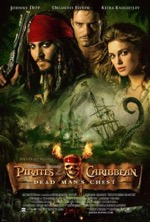
Starring: Johnny Depp
July 2006
“Depp and Crew Are Dead in the Water”
What happened? The first Pirates of the Caribbean movie was a rousing crowd-pleaser that featured one of the most memorable characters to grace the silver screen in quite some time, Johnny Depp’s swaggering lush, Captain Jack Sparrow. An unqualified success on every level, Pirates was a feel-good romp filled with red coats, nefarious pirates, stolen treasure and a skeleton crew, literally. Aside from Depp’s spellbinding performance and the witty dialogue assigned to him, what made Pirates sail was relationships: Jack and Will forging a tenuous friendship, Will and Elizabeth falling in love, Jack and Barbossa squaring off during the movie’s harrowing climax, etc.
In the sequel, entitled Dead Man’s Chest, these relationships are quickly discarded to service a plot that sees Jack and Will at each other’s throats and Elizabeth smooching Jack just a short time after her interrupted wedding—before they can say “I do,” Elizabeth and Will are dragged away in irons and slapped with the charge of treason for aiding Jack in the previous film. In order to receive a pardon, the couple must steal a special key from Jack. Jack, however, has troubles of his own as he’s been slipped the black spot and is desperately trying to avoid a sea-bound leviathan called a Kraken.
Along the way, they encounter many familiar faces from the past as well as the new baddie, Davy Jones (Bill Nighy), the squid-faced master of the underworld who holds absolute sway over his barnacle-encrusted crew. Onboard Jones’ magical ship, the Flying Dutchman, Will encounters his father, Bootstrap Bill; Will soon learns, much to his dismay, that a rescue attempt is impossible as his father has lost a wager and will spend the rest of his existence in servitude to Jones. In addition to a stealthy submarine mode, the Flying Dutchman can also summon the Kraken, which surfaces about every half hour just to keep things interesting. With the Kraken’s maw resembling a giant sphincter, the movie could be renamed Pirates of the Caribbean: Attack of the Butt Kraken…an adequate title for a grossly inadequate sequel.
Whereas the first Pirates movie was clever and amusing, the sequel is silly and confusing. Trying to make heads or tails of the writhing, often nonsensical plot is tantamount to understanding the dice game played by Jones’ crew. I have to give the writers credit for taking risks—Dead Man’s Chest certainly isn’t boring, though it does run at least a half hour too long. Unfortunately, despite their best efforts to avoid sequelitis, the writers have presented a story that, not unlike a sailor’s matted and tangled beard, is a disheveled mess. Besides the tenuous storyline, some of the movie’s action scenes are just downright ridiculous; like the dizzying sword fight on the runaway water wheel or the entire sequence involving Jack’s flight from the natives, which borrows heavily from Raiders of the Lost Ark and Return of the Jedi.
Silly scenes notwithstanding, the greatest tragedy here is that Captain Jack isn’t even remotely funny, and what’s more, isn’t even likable. His one-liners plummet like anchors, not because they’re poorly written, but because the character left his charm back at Port Royal. Somewhere between movies, either the writers or Depp himself lost Jack’s voice. Here he comes off more as a self-centered, cut-throat pirate and less like the irreverently insouciant debonair we fell in love with in the first movie.
After a dizzying two and a half hours, the movie ends on a low note; Captain Jack finally faces the Kraken and a dark cloud of uncertainty hovers over Will and Elizabeth’s relationship…the whole kiss thing. The “supposed” major twist ending is possibly the finest example of deus ex machina I’ve ever seen—and that’s no compliment. The arrival of the surprise visitor from the past is clearly intended to put an exclamation point on the film’s final moments, but instead, the strategy backfires and leaves the audience in a state of confusion—it’s a contrived cliffhanger that clumsily creates another loose end.
As the old pirate’s adage warns, “Dead men tell no tales;” unfortunately, the living ones didn’t have much to say here either. It’s been reported that parts two and three were filmed at the same time—to say that I’m dubious about the quality and potential of the third chapter would be colossal understatement. We’ll see if Depp and crew can right the boat. As for Dead Man’s Chest, it’s an aimless, listless and witless story that’s anything but shipshape.
Rating: 2
Superman Returns (PG-13)
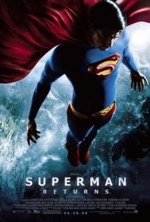
Starring: Brandon Routh
June 2006
“Long Overdue, ‘Returns’ is Overly Long and Overstated”
It could have been great!
That was the unsettling and unshakeable thought that kept echoing in my mind as I exited the theater after viewing Superman Returns. This was the movie I was most excited to see this summer…my prediction for the 2006 box office champ. While the later remains to be seen, the movie is significantly less than I had hoped for; a krypton-infused disappointment that neither hero-friendly director, Bryan Singer, nor newly minted pretty-boy, Brandon Routh, could salvage. Weighing in at an interminable two hours and thirty-four minutes, Superman Returns is a ponderous, somnambulating, seemingly alternate (Elseworlds) Man of Steel chronicle, which frequently parts ways with the continuity established in the previous film series, much to its detriment.
Last seen nineteen years ago in the debacle known as Superman IV: The Quest For Peace, Superman, one of the most beloved and enduring comic book icons, has finally returned to the big screen after eight attempts to revive the story with a veritable army of A-list directors and actors attached to the various rejected projects. Art imitates life as the story opens with Superman’s (Routh) second coming to earth after a five year trek to his annihilated home planet, Krypton. Things have changed: the world has adjusted to life without Superman. People have changed as well: embittered by Superman’s unannounced departure and extended absence, Lois Lane (Kate Bosworth) has written a scathing, Pulitzer Prize-winning article entitled, “Why the World Doesn’t Need Superman.” As Clark Kent chews on that unsavory morsel, he also discovers Lois is a mother and that the father, presumably, is Richard White (James Marsden of X-Men fame), nephew of redoubtable Daily Planet editor, Perry White (a severely underserved Frank Langella).
It doesn’t take long for Superman to leap back into action…Lois is onboard a malfunctioning jet that is rapidly plummeting toward Metropolis; unbuckled from her seat, she’s tossed around for most of the sequence and should be dead several times over, but the laws of physics and gravity, apparently, are different in Superman movies. Superman has super strength, but not super intelligence; this is evidenced in his futile attempt to slow the jet’s screaming descent by pulling back on one of the wings…the wing rips right off with him attached and he has to catch up to the plane. Learning from his mistake, Superman gets up under the nose of the craft and pushes with all of his preponderant might; stopping the plane just a few feet above ground, he gently brings the fuselage to rest upon the infield of a baseball stadium. The awestruck crowd wildly applauds his heroics…Superman has returned! The scene is a tad cheesy, but is well-executed and sets the stage for the rest of the movie…which brings us to Lex Luthor (Kevin Spacey).
I have a great deal of respect for Gene Hackman as an actor, but I never felt he struck the right cord with Lex in the earlier Superman movies…Lex’s brilliance was questionable, at best, and the character simply wasn’t menacing enough. Spacey wholly inhabits the nefarious billionaire and approaches the lofty bar for insidious villains set by Jack Nicholson, whose tour de force performance as the Joker made the 1989 Batman movie. In the same respect, Spacey, who rightfully receives top billing here, makes Superman Returns fly. Spacey’s Lex is well-dressed, well-educated and is surprisingly understated in most instances; he tiptoes along the edge of insanity, but never quite crosses the line. It’s amusing to observe Lex’ survival instinct kick in any time something threatens to go south: watch him in the model room before the power goes out.
Spacey’s contribution to the film cannot be understated or underestimated. If his performance could be distilled into a credit card commercial, it would say: “Superman Returns tickets: $10. Lex Luthor’s wig: $90. Lex’ witty banter with ditzy assistant, Kitty Kowalski (Parker Posey)…priceless!” You can tell the writers had a ball crafting dialogue for him; Lex has the best lines in the movie. “Didn’t your father ever teach you to LOOK BEFORE YOU LEAP?” Lex yells as he kicks the snot out of our severely weakened hero—krypton runs in veins through the crystalline surface of Lex’ New Krypton, formed by a stolen crystal from Superman’s lair.
Lex’ scheme to create new continents, and thereby kill billions of people, is a bit far-fetched…yes land is a valuable commodity, but as Lex himself states, the crystalline fortress he creates lacks warmth and looks alien. Who would want to live there? Would there be a Luthor’s Supermarket nearby? How would people walk or drive over the rugged surface? The demise of New Krypton (Superman thrusts it into space) reveals another nitpick…when Superman lifts the crumbling island, he’s out in the middle of the ocean, but when he falls back to earth, he lands in Metropolis’ version of Central Park.
If it hadn’t been for such super-sized plot holes, the unsatisfactory non-resolution of the movie’s tepid love triangle and a butt-numbing, half-hour dénouement, the movie might have been resplendent instead of merely decent. Though most of the movie plays like a highlight reel of the earlier films, it’s, ironically, Superman himself that is the film’s biggest liability. To be sure, Routh’s performance pays homage to the more endearing nuances of Reeves’ Superman while adding a modern twist, but some of Singer’s choices for this Man of Steel are questionable and controversial. Superman’s homoerotic appearance aside, Singer’s Kal-El is a voyeur who eavesdrops on Lois’ family. Interestingly, though Superman can hear millions of distinct voices from space, he has diminished auditory capacity when listening through the walls of Lois’ house.
One of the movie’s “big” scenes is where Superman catches the Daily Planet globe, which has fallen from the top of a skyscraper. Superman actually struggles with the globe before depositing it on a nearby car. Reeves’ Superman would have replaced the globe and soldered it with his ocular laser beams in three seconds flat. Though admittedly cornier at times, I miss the old Superman…he, at least, had some panache. The new Superman seems more concerned with Lois than anyone else…he flies out to rescue her from a flooding boat while abandoning the imperiled citizens of Metropolis—surely his services are still required in a city reeling from a seismic event.
As I involuntarily fidgeted in my theater seat, I began to wonder why I wasn’t enjoying the movie more. After all, the film is masterfully directed, well-acted and is a visual marvel. After some reflection, I’ve come to an inescapable conclusion…Singer has too much admiration for the source material. Singer tries too hard to impress; his painstaking efforts to create a signature film actually prevent the movie from achieving its maximum potential. His direction can’t be faulted, but he should have pared down the script…Singer crams two movie’s worth of material into one, and, for a film of this ilk, there are too many drawn-out conversations and too few all-out action scenes.
However, there are some great moments in the film, not the least of which is the scene featuring stock footage of Marlon Brando as Superman’s father, Jor-El and John Ottman’s rousing score that includes many of John William’s iconic themes—both of these memorable elements pay fitting tribute to Richard Donner’s landmark 1978 film.
In the final analysis, Superman Returns would have been far better if the ménage trios concept had been jettisoned, the Superboy storyline had been aborted and the death of Superman subplot had been scrapped. The movie would have been much stronger if the last twenty minutes had been excised…I really didn’t need to hear Superman’s tacky line, “I’m always around,” one more time. Singer’s Superman is a solid hit—a ground rule double—but is nowhere close to being a home run. No one can question that Superman Returns is good, but the realization that continues to vex me is…it could have been great!
Rating: 2 1/2
Click (PG-13)
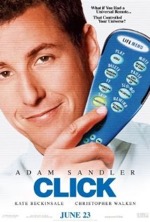
Starring: Adam Sandler
June 2006
“Not Even Remotely Entertaining”
The word tripe, as defined by Merriam Webster, is: something poor, worthless, or offensive. This definition more than adequately describes Adam Sandler’s Click. Finding even one redeeming quality in the movie would make hunting for a needle in a haystack an enjoyable pastime. Many of the movie’s themes and gags are abhorrent (i.e., the family dog repeatedly humping a large stuffed duck), and potty humor runs rampant throughout this severely modernized and significantly dumbed-down variation on Charles Dickens’ classic A Christmas Carol. Click, much to its detriment, suffers from the same brand of lowbrow idiocy that seems to plague the majority of Sandler’s films.
The story focuses on one man’s struggle to juggle the various aspects of his life; family, work, recreation, hobbies, etc. Michael Newman (Sandler) just can’t seem to get it right; the more he tries to organize his life, the more he falls behind and the angrier he becomes. But everything changes the day he falls asleep on a demo bed in a Bed, Bath & Beyond store. Waking up, Michael sees a door marked “Way Beyond.” Opening the door, Michael enters a gigantic warehouse filled with crates, a la Raiders of the Lost Ark, and meets eccentric scientist, Morty (Christopher Walken). Morty has the solution to Michael’s chronic busyness; a remote control that can control Michael’s life…remotely.
At first, Michael has so much fun with the remote control—he pauses a conversation with his boss (David Hasselhoff) and gives the man a migraine by slapping him silly, adjusts the color to make himself look like the Hulk and fast-forwards through whole arguments with his wife—that he fails to see its detriments. As time continues flying by and the remote’s preference mode skips ahead to major events in his life, Michael realizes he’s missing out on meaningful moments with those he holds most dear.
Though I can appreciate the film’s carpe diem sentiment, I just can’t abide Michael’s selfish preoccupation and obnoxious behavior; both character flaws are off-putting and significantly undermine Michael’s status as protagonist. While the movie’s moral is universally relevant, the story’s execution is ill-conceived and overly pedestrian. Still, the greatest narrative crime committed in the remedial screenplay, written by Steve Koren and Mark O’Keefe, is the utilization of the notorious “it was only a dream” twist…we can forgive Dickens for using it, but no such grace can be extended here.
Click passes up on a prime opportunity to tell a truly poignant tale and also squanders quality supporting performances by Kate Beckinsale, Sean Astin and Henry Winkler. Some will consider Click quality entertainment, but for me, I’d rather change the channel.
Rating: 1 1/2
The Lake House (PG)
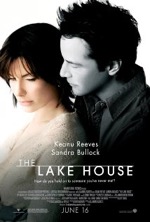
Starring: Keanu Reeves
June 2006
“Timeless Romance with ‘Speed’ Stars”
This type of movie has been done before, most notably in Frequency (2000), which starred Dennis Quaid and a pre-Jesus Jim Chaviezel as father and son separated by time but able to communicate via a HAM radio, which receives an ethereal signal boost from unusual solar flare activity in both time periods. At one point in that movie, Quaid, living thirty years in the past, places a wallet in a Ziploc bag and hides it under a loose floorboard, telling his grownup son in the future where to find it. Chaviezel immediately retrieves the wallet and uses it as a clue to track down a serial killer.
Mailing across time is taken to a whole new level in The Lake House, director Alejandro Agresti’s temporal romance starring Speed duo, Sandra Bullock and Keanu Reaves. Kate Forrester (Bullock) is a doctor at a large Chicago hospital; seeking refuge from the frenetic pace of city life, Kate moves into a lake house on the north shore. Once settled in, Kate finds a forwarding note from the previous tenant, Alex Wyler (Reaves), inside the mailbox (which becomes the focal point of the movie and the conduit through which the characters communicate with each other). Mistaking the note as a prank, Kate writes a response to Alex, sets the letter inside the mailbox and raises the flag. As soon as Kate turns to go, the flag drops. Inside the mail box is another message from Alex, ardently claiming veracity on his part and belying any notion of a practical joke. As Kate and Alex continue exchanging notes over the next few days, they make an astonishing discovery—though Kate and Alex inhabit the same physical space, they exist in two different times. Kate lives in the present day (2006), but Alex is writing her from 2004.
Though the movie’s plot is a little too convoluted at times, it’s a tight yarn with an interesting character study, particularly in Kate’s case. At some point, Kate realizes she’s falling for a man she can never have; a bitter reality that exemplifies her life and ongoing struggle to find fulfillment. One of the finest scenes in the movie is when Alex takes Kate on a virtual walk with the assistance of a map and prerecorded cassette tape; Alex’ commentary is conveyed in a series of voice-overs, and, as an architect, he describes some of Chicago’s landmark buildings in great detail. It’s a touching moment, but when complications surmount and a relationship with Alex seems more and more impossible, Kate severs all communication with Alex. Kate concludes that Alex was “just a beautiful fantasy where time stood still,” and decides to move on by letting go of the past.
The movie’s unconventional resolution caps off a moving, thought-provoking love story that succeeds by placing emphasis on plot and character and not on a contrived or commonplace romance…the fact that the leads barely encounter each other aids the movie in subtle yet powerful ways, producing yearning in the characters as well as the audience. Some mysteries remain unexplained, however; such as how the couple can communicate in the first place. It may seem coincidental that both Kate and Alex have the same pet, a female dog oddly named Jack, but I believe the canine is the key to their ability to communicate with each other across time. Jack barks and runs away when Alex’ friend, Mona, makes a pass at him and the dog leads Alex to Kate’s birthday party where couple first meet. At times, the dog almost seems sentient. Could it be that Jack (an alien or supernatural being in disguise) is orchestrating events to bring the lovelorn couple together? It’s as good an explanation as any, I suppose.
Though the pacing is slow at times, the movie has great atmosphere—Agresti makes excellent use of the breathtaking lake house set, built, according to the story, by Alex’ absentee father, Simon (Christopher Plummer). Simon’s discourse on the proper use of light in architecture is memorable, though not necessarily crucial to the story. As for Bullock and Reaves, their acting isn’t memorable in the least, but that’s exactly what the script requires…less-nuanced performances would have overpowered the plot and distracted the audience from what turns out to be a first-rate love story, garnished with a sprig of suspense and seasoned with a sci-fi paradox.
Jane Austen’s Persuasion is referenced on several occasions in the movie and that novel’s themes of waiting for the right time and receiving a second chance find modern expression in The Lake House.
So the next time you go outside to mail a letter, if your mailbox flag suddenly drops after you raise it, it’s probably just a loose screw, the pull of gravity or a stiff breeze. But just in case, check it anyway.
Rating: 3
Cars (G)
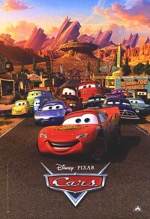
Starring: Owen Wilson
June 2006
“High-Octane Joyride Leaves Other Animated Films in the Dust”
I have to admit it…I’m one of those rare guys who just isn’t into cars. I know how to change an air filter, but that’s the extent of my automotive prowess. My windshield wipers need to be replaced, but I keep procrastinating; putting it off for a rainy day. The NASCAR gene skipped me and went to my older brother, Mike. Growing up, I remember particular Sundays when Mike would sit on the couch all afternoon and watch an entire three hour motor-fest (more times than not, he’d drift off to sleep midway through the race). It fascinated me to no end that a person could be perpetually entertained by different colored cars going in circles for hours on end; then again, I’ve been known to spend the same amount of time watching twenty-two players fighting over an elliptical leather ball.
The newest animated foray by Pixar is simply titled Cars. Celebrating twenty years of excellence in animated entertainment, Pixar knows how to appeal to a mass audience. Their last outing, The Incredibles, was right up my alley, but many people aren’t into the whole superhero thing. Even so, they still turned out in droves to see the only Pixar presentation to date that features humans. I firmly believe that Pixar can take any topic or genre and find a way to make it appealing to a demographic wider than Elastigirl’s reach. And with Cars, you don’t have to know the difference between a lug nut and a corn nut to appreciate the amazing animation, colorful characters and exhilarating story.
The movie begins with a high-octane race known as the Piston Cup, which results in an unprecedented three-way tie between retiring veteran, The King (voiced by race legend, Richard Petty), aggressive upstart Chick Hicks (Michael Keaton, fresh off his turn in car-centric Herbie: Full Throttle) and hot-shot rookie, Lightning McQueen (Owen Wilson). In one week, the three cars will go head-to-head in a tie-breaker in L.A. to determine, once and for all, the Piston Cup champion.
McQueen, a self-professed “one man show,” fires his pit chief and refuses to give up a lead in order to change tires. A bona fide prima Donna, McQueen hogs the camera every chance he gets, but is chagrined each time he does an advertisement for his small-fry sponsor, Rust-eze. McQueen’s dream is to be endorsed by mega-sponsor, Dinoco, but his repeated attempts to woo the company are to no avail.
On the way to the big race, McQueen falls asleep at the wheel and wakes up in the middle of the desert. The cherry-red race car soon drifts into Radiator Springs, the quintessential town that time forgot. An eccentric burg stuck in neutral by small-town mentality, Radiator Springs is chock-full of dented fenders, rusted frames and faded neon signs. As McQueen desperately attempts to escape “hillbilly hell” and get to California in time for the big race, he gradually begins to understand the townsfolk and their struggle to matter in a world that’s passed them by.
Though it takes a while to rev up its narrative engine (the first half of the movie doesn’t have near the same horsepower as Pixar’s previous outings), the film is a rollicking good time once it gets up to speed. The movie is brimming with memorable characters like Doc Hudson (a.k.a. The Hudson Hornet, three time Piston Cup winner), voiced by screen giant Paul Newman, McQueen’s romantic interest, Sally, voiced by Bonnie Hunt, and the dumb-as-a-post rust-bucket named Tow Mater, brought to life by Larry the Cable Guy. Mater, who claims to be the world’s best backward driver, steals the show with his dim-witted antics. The scene where Mater shows McQueen the finer points of Tractor Tipping (“Tractors is so dumb,” he informs McQueen), is one of the most memorable moments in the movie. Mater’s life-long wish is to take a helicopter ride, and when his dream comes true at movie’s end, his line, “I’m happier than a tornado in a trailer park,” is the funniest I’ve heard this year.
Beyond all the flashy cars, inside gags, creative flourishes and eye-popping CGI, there are several wonderfully tender and powerfully poignant messages in the movie, one of which finds expression in James Taylor’s wistful song “Our Town.” Themes such as learning to rely on others, the fear of becoming obsolete and the need to slow down and enjoy life are all subtly woven into a tale that would have broken down after a few laps had it solely focused on spark plugs and fan belts. No Mater what, Pixar is still the undisputed king of genuine human storytelling with anthropomorphized characters.
Rating: 3
A Prairie Home Companion (PG-13)

Starring: Lily Tomlin
June 2006
“Fitting Tribute to Keillor’s Off-Kilter Variety Show”
My first exposure to Garrison Keillor was in the early 80s when I watched his “A Prairie Home Companion” variety show every Saturday night on the Disney Channel. As a teen I thought GK (as Keillor is frequently referred to in the movie) was dry and boring, and yet I found myself frequently chuckling at the exploits of the down-home folk of fabled Lake Wobegon, MN, where “the women are strong, the men are good-looking and all the children are above average.”
Much like the actual show, Robert Altman’s A Prairie Home Companion is a bizarre effort. The movie centers on the program’s final show, which is broadcast over the radio and also performed in front of a live audience at the F. Scott Fitzgerald Theater in downtown St. Paul, MN. The film’s synergistic appeal is due largely to the variegated acts that take place on stage as well as the wonderful character moments behind stage and in the dressing rooms, all of which unfurl in real-time.
Take security man Guy Noir (Kevin Cline) for instance; all of his bits are fittingly shot in a film noir style as if he’s a kind of backstage detective. And then there are the Johnson sisters, Yolanda (Meryl Streep) and Rhonda (Lily Tomlin), who very nearly steal the show with their witty, fast-paced dialogue and amusing anecdotes. Yolanda’s daughter, Lola (Lindsay Lohan), has a few scenes, but doesn’t really factor into the story in any significant sense. Two singing cowboys, Dusty (Woody Harrelson) and Lefty (John C. Reilly) bring the house down with their naughty, bawdy, rip-roaring song, “Bad Jokes.” The Academy will officially put the T in travesty if “Bad Jokes” isn’t nominated for an Oscar—the song is the undisputed highlight of the film.
Tommy Lee Jones plays Axeman, the stiff suit sent to shut down the show after its final performance. Axeman is the closest thing the movie has to an antagonist, but other than providing occasional reminders about the show’s demise, the character doesn’t add much to the film. The most avant-garde element in the movie is the mysterious appearance of The Dangerous Woman, played by the lovely Virginia Madsen. Living up to her name, the blonde, white-gowned beauty is a major departure from the traditionally-drawn grim reaper with dark robe and scythe. The Dangerous Woman will claim someone’s life by the end of the night, a dreadful realization that creates ample tension while raising the question: Which character will become her unwitting victim?
Altman (Nashville) was a natural choice to helm this project; few directors can rival his attention to detail and character or approach his genius at taking everyday situations and presenting them as new, unique or quirky reflections of reality. A Prairie Home Companion, like many of Altman’s films, is a cinematic odd bird, but it’s also charming and inspiring in subtle ways. Due to the movie’s singular focus, limiting locale and real-time narrative, some spectators might get antsy toward the middle of the film. Though most of the vignettes are entertaining, the movie has an accumulative resonance, the full impact of which can only be experienced when reflecting on the film as a whole.
A Prairie Home Companion succeeds at honoring Keillor’s variety show while wistfully whisking us back to the mythical and magical days of early Americana; where neighbors were neighborly, deals were made with a handshake and families sat around a box to be entertained at night: Radio, not TV. Keillor’s eclectic program will forever be remembered as a conduit to an earlier, simpler time when folks lived, loved and died...somewhere out on the prairie.
Rating: 3
X-Men: The Last Stand (PG-13)
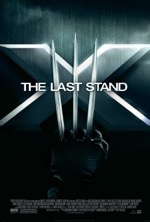
Starring: Patrick Stewart
May 2006
“Dark, Tragic, yet Satisfying ClimaX”
Evolution. It’s what happens with each new X-Men movie. With Bryan Singer at the helm, the first two X-movies told the origin tales of many of the major mutants while previewing the brewing war between humans and mutants. But when Singer exited stage left in mid-production to direct Superman Returns, the prevailing questions became: 1.) Who will complete the third installment, and 2.) Will the trilogy’s final chapter forever be tarnished by a different vision? Enter Brett Ratner (Rush Hour), who, in addition to crafting a big budget sequel for a series adored by millions of fans, had the unenviable challenge of living up to the impossibly lofty expectations of those fans, while simultaneously enduring the scrutiny of a largely-dubious media. At times, I’m sure Ratner could identify with Wolverine when Magneto levitates the lupine hero and manipulates his adamantium skeleton to produce unthinkable pain.
Each X-Men movie sees the inclusion of new mutants—good and bad—into the ever-expanding roster of mutantkind, and this time around, the fresh faces belong to Beast (Kelsey Grammer) and Angel (Ben Foster) on the good side and Juggernaut (Vinnie Jones) and Callisto (Dania Ramirez) on the bad side. A new mutant classification system is introduced in the movie: Professor X (Patrick Stewart) and Magneto (Ian McKellen) are Class 4 mutants; Jean Gray (Famke Jansen) is the only Class 5 mutant Prof. X has ever encountered.
Jean’s part in the story is the most tragic: last seen helping Prof. X and the other mutants lift off in their stealth jet while being swallowed by Alkali Lake, Jean reemerges as a being of frightening power called Dark Phoenix. Jean, we now learn, has a dark side that Prof. X has always kept locked away for her own good, but Magneto feels she’s being held back from achieving her highest potential and seeks to recruit Phoenix to join his Brotherhood of Mutants. The saying, “Absolute power corrupts absolutely,” is painfully illustrated by Phoenix, whose heinous acts will surely shock some viewers—this isn’t the soft-spoken, nurturing heroine we’ve come to know in the earlier films.
On another front, scientists at Worthington Labs (situated atop Alcatraz Island) have discovered an antibody that can “cure” mutants by transforming them into normal humans. The impending war between humans and mutants—as foreshadowed in X2—heats up to a full boil as battle lines are drawn and troops are marshaled on both sides. Even as less-radicalized mutants line up to receive the cure, Magneto rallies his throng of minions with an impassioned speech, “They wish to cure us, but I say we are the cure!”
Rogue’s (Anna Paquin) ambivalence concerning the cure is the most powerful stanza in the film. Her mutant power (she can suck the life force out of another living being with a simple touch), though useful in combat, has a terrible drawback—since she can’t make physical contact with anyone, she will forever be alone. Rogue’s desperate act is a mirror reflecting our own insecurities and basic human needs—her desire to be touched, held and comforted is a cry for love that resonates with universal salience.
Fan favorite, Wolverine (Hugh Jackman), faces a new challenge this time around…the burden of leadership. The transformation from Lone Wolf to Leader of the Pack is an arduous one; especially when his animal impulses and natural instincts to take care of number one come into direct conflict with the increasing demand for teamwork. The lesson he learns in the opening sequence inside the Danger Room (the holodeck-like training room that die-hard fans have been clamoring to see) sets up one of the movie’s most memorable scenes in the climax.
As in the two earlier films, the acting is nothing short of stellar, and the standout performance here is Kelsey Grammer as Hank McCoy/Beast. Grammer wholly inhabits Beast and endues the furry blue mutant with the sagacity and refinement befitting a dignitary—his performance is thoroughly enjoyable.
If the movie has a down side, it’s the lack of attention given to the new mutants. Though Juggernaut’s simple sentences match the mental capacity of the character, Angel, who figured to be a prominent player judging from the trailer and marketing campaign, is only given a half dozen lines. As I said in my review for X2, these films “are overstuffed with good guys.” That statement is even more apropos of X3; most of the new mutants are of the disposable variety and have scant onscreen time.
However, if Ratner’s fourth quarter quarterbacking has earned him any commendation it should be for his unwavering resolve to stay the course and take X-treme risks. Major characters die in the movie. Onetime friends become enemies. Due to its darker tone and tragic climax, (or because of Singer’s absence), this third X-Men installment will most likely be the least popular of the trilogy, but, to his credit, Ratner refused to play it safe.
The Empire Strikes Back is my favorite original trilogy Star Wars movie because the Evil Galactic Empire finally gives the ragtag rebellion a bloody nose. It isn’t uplifting, but it is realistic; and those are the qualities I most admire about X3. Besides, who ever said the final chapter of a saga has to end on a happy note? Sure, the grand finale of an action-packed trilogy can feature furry little Ewoks dancing around a bonfire and singing “Yub, Yub,” but I’d rather see a winner-takes-all, battle royal between trained military personnel, the X-Men and Magneto’s mutant army. Who wouldn’t?
So, will this be the final X-Men movie? Before coming to any conclusions, make sure you stay through the ending credits.
Rating: 3
Over the Hedge (PG)
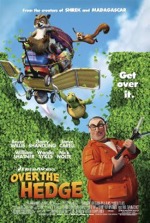
Starring: Bruce Willis
May 2006
“Great Characters/Plot Put ‘Hedge’ Over the Top”
RJ (Bruce Willis) is a self-assured raccoon who makes the costly mistake of lifting food from the cave of a hibernating bear. When the bear is awakened by the racket it accosts the jittery raccoon and RJ accidentally nudges the brimming shopping cart over the side of the mountain. The cart crashes onto a highway where traffic makes short work of the food, scattering it all over the road. Vincent the bear (Nick Nolte) threatens to do bodily harm to RJ if the raccoon is unable to replace all of the stolen food within one week’s time.
And thus begins the lighthearted tale of RJ and the community of animals that befriend him—and unwittingly aid him in settling his debt with the bear. When the animals come out of hibernation, they’re startled by the formidable presence of a gigantic green wall which has sprung to life while they were sleeping. The adorable little squirrel, Hammy (Steve Carell), calls the green barrier “Steve” for lack of a better appellation. All of the animals, including the skunk couple, Lou (Eugene Levy) and Stella (Wanda Sykes), father and daughter possums, Ozzie (William Shatner) and Heather (Avril Lavigne), and the reticent half shell leader, Vern (Garry Shandling), stand in awe of the massive hedge. It’s not long before one of the animals ventures through the thicket and emerges into a strange new world known as suburbia.
RJ has already been over the hedge and serves as tour guide to his dumbstruck companions; RJ’s commentary on the oddities of human behavior is simultaneously amusing and indicting. Observing the animals as they interact with our world is the engine that makes the movie run…along with the laugh-a-minute gags and memorable one-liners.
Each member of the star-studded cast does a superb job, but the decision to utilize Shatner’s over-the-top delivery for the demonstrative possum was a stroke of genius. The tip of the hat to Citizen Kane—Ozzie dramatically delivers the word “Rosebud” before passing out onto the blacktop—is a priceless moment. Instructing his daughter in the way of the possum, Ozzie later tells Heather, “We die…so that we can live!”
The old adage, “Everything that’s old will be new again” is especially true of Stella’s transformation from skunk to cat, which pays fitting homage to Warner Bros. classic Pepe Le Pew shorts. After undergoing some cursory cosmetic surgery, Stella is dispatched to a rich woman’s backyard to distract the family cat, while the rest of the animals sneak inside and raid the kitchen.
My pick for funniest scene is where Hammy chugs a sugary soda and charges across the woman’s lawn; freely moving through a motionless world in a Matrix-style slow-motion run. Though the young skunks are clearly patterned after the Madagascar penguins, the scene where they work together to drive the SUV is also uproariously funny.
Over the Hedge is a crowd-pleasing, family promoting film that employs colorful characters in a heartwarming story. In an era where animated movies have oversaturated the market, Over the Hedge stands out as an above-average effort that is certainly worthy of Oscar consideration for Best Animated Feature Film of the Year.
Rating: 3
Poseidon (PG-13)
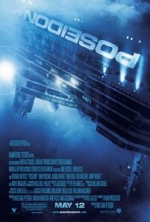
Starring: Josh Lucas
May 2006
“Mayday…Our Screenplay Has Capsized!”
With some movies, you can just tell going in that it’s destined to be a disaster. When you have that premonition during an actual disaster movie, it’s like adding salt (water) to an open wound. And, when that floundering disaster movie is a remake of a mediocre original, you know it’s time to refill your popcorn, because it’s going to be a long two hours.
Poseidon, the follow-up to Irwin Allen’s 1972 thriller dubbed The Poseidon Adventure, is such a movie. The original starred Gene Hackman, Ernest Borgnine, Red Buttons, Roddy McDowall and Shelley Winters. The update stars Josh Lucas, Kurt Russell, Jacinda Barrett and Richard Dreyfuss. Clearly the original cast edges out the new crew, but special effects honors go to the new movie. And if eye-popping FX were the only criterion on which a movie is judged, Poseidon would be up for a Best Picture Oscar this year. Fortunately, spectators are also looking for something called plot, a structure quickly jettisoned with the flotsam after the cruise ship is capsized by a rogue wave (okay!) and a handful of brave passengers embark on a dangerous journey through flooded decks and ventilation shafts (one of the only genuinely terrifying moments in the movie) to reach the top of the ship, which is now the bottom.
The exterior and interior design of the Poseidon cruise ship is radiant and elegant…it’s too bad we never have a chance to stretch our legs a little (as was masterfully accomplished in Titanic), before the disaster occurs. The movie wastes no time on character development…the ship is upturned near the twenty minute mark, long before we learn that Robert Ramsey (Russell) was a firefighter (Backdraft flashback) and, more importantly, former mayor of NYC. Robert is overprotective of his daughter, Jen (Emmy Rossum); she and her beau are joined at the hip on the ship, but they never find the right time to inform dad that they’re engaged before their lives are turned upside down, literally. There’s a potty-mouthed poker player named Lucky Larry (Kevin Dillon), who could have been a decent antagonist. Unfortunately, he’s killed off before we really even have a chance to start loathing him…another snafu with the script’s cursory attention to character and detail.
Dreyfuss, fittingly, plays Richard, an architect who serves as set-dressing and the movie’s token gay person. Lucas’ character is a card hustler named Dylan. Dylan seems to know everything about the ship—he guides the group each step of the way and seems to have the answer for every challenge (he’s even a step ahead of Robert in detecting the effects of a flash fire). Dylan takes a leadership role even though he claims to be a lone wolf…by the end of the movie he learns some teamwork skills, but does anyone care? As the picture’s supposed hero, Dylan fails miserably—the character isn’t noteworthy in any respect and his supreme confidence is off-putting (this is just another in a long string of uninspired performances turned in by Lucas…he’s no leading man).
However, in all fairness to Lucas, his performance isn’t what ails the movie the most; after all, the story is nothing more than one imperilment after the next and the dialogue is as leaden as the ship’s hull. Case in point: Dylan has a Eureka moment and proposes that the survivors exit the ship via the propeller shaft, stating, “The only thing between us and the outside is nothing!” (Did Yoda write the screenplay?)
Spoiler Alert: What’s supposed to pass as a major twist near the movie’s end is merely a rehash of Bruce Willis’ heroic demise in Armageddon…Robert sacrifices himself so that Jen and her new fiancé can have a chance to live. It’s ironic, but Robert’s struggle to find the emergency shutoff button, while his body spasms from the lack of oxygen, is the highlight of the movie—Russell delivers the finest underwater death scene I’ve ever witnessed in a film.
The movie’s paint-by-numbers conclusion is predictable and unsatisfactory in every way (i.e. there’s a handy raft nearby and the rescue helicopters arrive within minutes). A more interesting climax would have shown the survivors being eaten by some famished sharks…at least that would’ve provided us with some drama. Poseidon is a listing, floundering affair that comes complete with deep water and shallow characters. It works as mindless entertainment, but fails to live up to the original and doesn’t even belong in the same category as director Wolfgang Petersen’s previous sea-faring films: Das Boot and The Perfect Storm. There’s little adventure in this Poseidon!
Rating: 2
Just My Luck (PG-13)
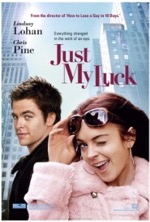
Starring: Lindsay Lohan
May 2006
“Polar Opposites Attract in Lucky Lohan’s Love Story”
Years ago I had a roommate who was unbelievably lucky; if it wasn’t for the fact that he was such a genuine, charismatic, decent, all-around good guy who deserved every gift that was ever lavished upon him, I probably would have gone stark raving nuts. Were it anyone else, I would have been nauseous every time the woman behind the bakery counter gave him an extra cookie for free, or when a generous stranger sold him a car for a dollar after learning he was without transportation (the honest to goodness truth). But, I can’t begrudge my ex-roommate any of this; he’s a quality person, someone who can walk right up to anybody and become their best friend within five minutes. The funny thing is…his ability to seem helpless, and thereby receive countless acts of charity, was completely lost upon him until I pointed it out to him. He eventually came to the realization that his was truly a charmed life. Perhaps you know someone like this.
When it comes to luck, Ashley Albright (Lindsay Lohan), reminds me of my ex-roommate. A spirited and overly-optimistic debutante, Ashley has everything going for her; beauty, talent, wealth and most of all, luck…the second she steps outside into a downpour, the rain, as if sensing her presence, ceases to fall. Ashley’s never known a loosing lottery ticket and when she hails a taxi, every cab in the vicinity converges upon her position. Her polar opposite, Jake Hardin (Chris Pine), is a walking calamity; Jake’s an affable, well-intentioned young man who just has terrible luck…when it’s not raining on him, pigeons are pooping on him. And, just when it looks as if his fortunes might change (Jake finds a five dollar bill in the trash can), he discovers that fate has played a nasty trick on him (he picks up the bill and gets warm, mushy poodle poop all over his hand).
Ashley and Jake eventually meet at a masquerade party. Jake ushers Ashley onto the dance floor, and in a fateful moment of passion, they engage in a lingering kiss that reverses their luck. Ashley becomes a hapless klutz and gets a taste of how folks live on the other side of the luck spectrum…she’s fired from her job and thrown in jail for unwittingly setting up her boss (Missi Pyle) with a male escort. Jake’s fortunes immediately change for the better; he saves the life of a big shot record producer and secures a contract for the band he’s been promoting, McFly (an obvious homage to Back to the Future). McFly is poised for their big break, but when Ashley kisses Jake to get her good luck back, things come crashing down upon Jake and the band. Ashley’s conscience forces her to make a terrible (by chick flick standards) choice: In order to get the man of her dreams, she must give up her life of ease and forever be unlucky.
Lohan has come a long way from her Parent Trap days, but it’s as if she’s got one wing outside the cocoon and is just waiting for the right role to come along to free her from her teeny-bopper chrysalis and establish her as a full-fledged movie star. Lohan is superstitious in real life, which perfectly plays into her part and the story in general; but we’ve seen the whole “role reversal” gimmick before in some of her other movies, most notably, Freaky Friday. It’s high time for Lohan to turn over a new (tea) leaf, and play a part that has some depth and believability.
Pine is a breath of fresh air in the movie, and if the film is successful in any way, it’s due in large part to his skilled portrayal of a young man plagued by Murphy’s Law. We can identify with his character more than Lohan’s because he’s a guy who’s making his way in the world while just trying to make it through the day…Lohan’s debutante is a spoiled brat who deserves her comeuppance when she looses her luck.
Director Donald Petrie (Miss Congeniality) has served us up a reheated version of Danny Glover and Martin Short’s Pure Luck. In that film, unlucky Short is hired to find the missing daughter of a wealthy businessman. In the end, the theory that one unlucky soul will find another is proven true in the highly amusing tale. Whereas, Pure Luck is a comedy; Just My Luck is a chick flick replete with silly scenes like the sudsy explosion in Jake’s laundry room or the sequence where Ashley kisses twenty guys in an attempt to find the man who stole her luck. The movie tells us that “the wheel always spins back.” Maybe the wheel can give me back my two hours…that would be lucky!
Rating: 2
Mission Impossible III (PG-13)
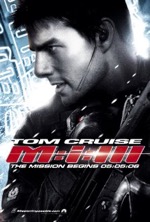
Starring: Tom Cruise
May 2006
“Abrams Sets His Cruise Control on Full Throttle”
Your mission, should you choose to accept it, is to determine if number three measures up to the first two Mission Impossible movies. After a six year sabbatical, Tom Cruise has finally reprised his role as uber-spy, Ethan Hunt, leaving behind him Woo’s woes and finding new direction from small-screen alchemist, J.J. Abrams.
With most movies, it’s expeditious to pick one or two key scenes and build a review around them. That practice is made virtually impossible by M:i:III, which contains so many high-impact action sequences and jaw-dropping twists, a detailed review could easily take up ten pages. Truth is, most movies claiming to be packed with nonstop action scenes couldn’t hope to keep up with M:i:III—it’s that fast-paced.
I could go into detail about the opening rescue attempt involving a frenetic shoot-out and a thrilling helicopter pursuit through a field of hydraulic windmills, or the well-executed, Bond-like break-in of the Vatican, or Cruise’s riff on Jack Bauer when he threatens to jettison antagonist Davian (Philip Seymour Hoffman) from a cruising plane, or the taut action sequence on the bridge when Ethan and Co. are pinned down by rocket-launching jets or any of a half dozen other great action scenes, but I won’t. The one scene worth focusing on is the teaser, which becomes a wraparound near the movie’s climax. The face-off between Hunt and Davian succeeds on a variety of levels: 1.) it sets the tone for the rest of the movie, 2.) it introduces nefarious Davian and the serious threat he poses, and most importantly, 3.) it hooks the female audience by placing Ethan’s fiancé, Julia (Michelle Monaghan), in harm’s way—Davian threatens to kill her unless Ethan provides him with the location of the Rabbit’s Foot, the movie’s MacGuffin.
My wife isn’t a fan of action movies, by any stretch, but she was engaged the entire movie because she had to find out what happens to Julie. Let’s face it, this kind of movie is squarely aimed at the masculine set, but it was an unqualified masterstroke by writers Alex Kurtzman, Roberto Orci and Abrams to involve the female spectators in such a tangible and personal way…this is an action film that even women will enjoy. Of course, many female viewers would visit the multiplex just to see Cruise in a tight, sweat-drenched T-shirt and running for his life—as he does in 90% of his roles.
Despite sofa-jumping shenanigans, Cruise’s acting has steadily improved over the years; his performance here is multi-layered, emotional and believable, thanks in large part to Hoffman, who, by his very presence, forces Cruise to bring his A game. Cruise flexes his acting muscles and musters just enough star power to pull off the part. The sheer physicality of the role glosses over any acting deficiencies, and as such, Ethan Hunt is the perfect role for Cruise…it’s demanding physically, but isn’t overly demanding dramatically.
Hoffman’s Davian is one of the finest, cold-blooded villains to grace an action movie in recent years. Unscrupulous and devoid of compunction, Davian is a driven man who will stop at nothing to get what he wants; he doesn’t even flinch when Ethan threatens to cut the solitary cord that anchors his seat to the plane. Thanks to Hoffman’s unforgettable performance, file Davian under “Delectable Villain.”
Besides the main action, the intrigue at the IMF between Hunt, Musgrave (Billy Crudup) and Brassel (Laurence Fishburne) also sustains interest throughout the movie. The writers do an excellent job of dealing out reverses until they finally reveal the mole during the movie’s harrowing climax.
M:i:III is an exhilarating, pulse-pounding thrill-ride that starts out in high-gear and refuses to slow down for stragglers. The only disappointment I have with the movie is that Cruise’s price tag—an unprecedented 200 million—will undoubtedly sink the project and cast a pall of uncertainty over future MI missions. Speculations aside, M:i:III fulfills its mission with vigor and panache, and as such, this review will self-destruct in five, four, three…
Rating: 3
Akeelah and the Bee (PG)

Starring: Keke Palmer
April 2006
“This Bee Might Not Sting, but It Sure Inspires”
In many ways, young Akeelah Anderson (Keke Palmer), eleven year old African American student at south LA’s Crenshaw Middle School, is a living, breathing indictment against our education system. Brilliance so often goes unnoticed in overcrowded classrooms with beleaguered teachers destined to languish in a system that frequently fails to cultivate genuine talent, but rather, funnels students into the same general education model that’s endured for centuries.
Perpetually feeling out of place, Akeelah is bored to tears at school—she only turns in half of her assignments. For extra credit, Akeelah enters the school’s spelling bee and draws the attention of her principal and Dr. Joshua Larabee (Laurence Fishburne). Impressed by her raw talent, both men encourage Akeelah to enter the regional spelling bee. Akeelah initially resists, but after some minor cajoling from her elders she accedes and shows both her inexperience and potential at the competition.
Soon after, Larabee (can writer/director Doug Atchison’s play on words bee any more obvious?) becomes Akeelah’s coach and he immediately establishes some ground rules: jive talk is out; learning the roots and origins of words is in. Among the many challenges the word wizard faces is Akeelah’s toe-in-the-dirt demeanor, which comes complete with poor eye contact and church mouse decibel speech. Larabee instructs the youth, “You can’t be a shrinking violet.”
As Larabee continues broadening Akeelah’s understanding of the power of language, Akeelah’s overprotective mother (played to perfection by Angela Bassett) catches wind of her daughter’s extracurricular activities and forbids Akeelah’s participation. This subplot reminds me of a similar scenario in Sister Act II when Lauryn Hill’s controlling mother prohibits her from singing. Fortunately, the story doesn’t get bogged down over this plot point but focuses more on the stimulating practice sessions and nail-biting competitions. Though much of the narrative is predictable up until the Scripps National Spelling Bee, the finale showcases some excellent acting and an unpredictable, wholly satisfying surprise ending.
In its broad strokes, Akeelah reminds me of the similarly themed family film Searching for Bobby Fischer (1993). Both movies feature a prodigious youth attempting to advance amid fierce competition, a tough yet caring tutor, a heart-stopping finale and a memorable supporting performance by some guy named Fishburne. The young phenoms in both movies also exhibit humility and good sportsmanship…refreshing qualities to see in young people even if they are merely projections on a screen.
Akeelah is the first movie co-produced by Starbuck’s Entertainment…yep, the coffee juggernaut isn’t satisfied with simply serving millions of lattes and getting filthy rich off of people’s hijacked taste buds. Now they must make movies too…so that people have something to do while drinking more of their product. Oh, I know a word for that: I-N-S-I-D-I-O-U-S.
Despite its dubious production company, Akeelah is an inspirational movie for all ages and subtly drives home the importance of community, friendship and perseverance. Akeelah is a feel-good, follow-your-dreams film that manages to keep the schmaltz factor to a minimum while delivering a heartfelt message one carefully chosen word at a time. So, if you have a penchant for hearing preternatural preteens promulgating pulchritudinous profundities, Akeelah is the movie for you. Word!
Rating: 3
The Sentinel (PG-13)

Starring: Michael Douglas
April 2006
“Paranoid Thriller Hits the Mark with Star Power and a Taut Plot”
The Secret Service: one of the most well-trained, well-equipped and well-informed agencies on the planet. Fiercely loyal to America and the president, Secret Service officers represent the finest our country has to offer—unswerving patriots who would gladly die to protect national security. Pete Garrison (Michael Douglas) is such a man—he took a bullet for Reagan in 1981. In today’s terror-filled world replete with blurred lines and shifting loyalties, the haunting question has become: Could such a man be bought, and if so, at what price? Could there be spies in our country or traitors among our government’s elite force, the president’s last line of defense?
As the movie opens, new intelligence suggests that an attempt will be made on the president’s life (a daily occurrence in real life) and that there’s a mole inside the Secret Service. An agency-wide mandate requires all agents to subject themselves to a lie detector test. Pete fails the test, and when a fellow agent turns up dead, suspicions, naturally, are cast in Pete’s direction. Pete’s protégé, Dave Breckenridge (Kiefer Sutherland) and his newly assigned assistant, Jill Marin (Desperate Housewives’ Eva Longoria) are given the task of locating Pete and bringing him in on the charge of treason—a task Dave eagerly accepts since Pete slept with his wife years earlier (ironically, Pete is currently having an affair with the 1st Lady, played by Kim Basinger).
What ensues is a chase somewhat reminiscent of Harrison Ford’s flight from the U.S. Marshals in The Fugitive. The pursuit ends at a shipping yard where Pete makes a convincing argument for his innocence…Dave lets Pete escape. Later, Dave becomes more convinced of Pete’s veracity when he finds Pete running tests at Langley. Dave surmises, “A guilty person wouldn’t break into a crime lab to prove his innocence.”
One of the more pulse-pounding scenes in the movie is where an agent flips a coin and unwittingly determines the president’s fate: heads, the president goes in a motorcade, tails, he takes a helicopter. In a sequence seemingly spliced in from Sutherland’s 24, a rocket sails through the air, collides with the helicopter and transforms it into a plume of smoke, flame and debris. Fortunately, fate and the coin sent the president home in the motorcade instead of the helicopter.
The other standout scene, at least for testosterone-driven viewers (let’s face it, the movie’s target audience), is the final shootout at the political summit in Toronto. An assassin casually sits in a stairwell and picks off anyone who comes around the corner—hoping to score a hit on the president. Again, fortune smiles upon the pinned-down president when one of the mole’s accomplices has a change of heart and dies protecting the commander-in-chief. Pete and Dave arrive, not a moment too soon, and take out the assassin and his cronies. A tenuous friendship forms between ex-partners in the contrived dénouement; the movie’s feeble attempt at forcing a happy ending where one isn’t required.
The Sentinel has an identity crisis of sorts—the focus keeps bouncing back and forth between Pete and Dave like a tennis ball at Wimbledon. The movie isn’t a vehicle for either Douglas or Sutherland, but is, ironically, better off for just that reason…a film spotlighting either character, exclusively, would have flopped. As it is, The Sentinel has just the right mix of action, suspense, romance, political intrigue and character dynamics to please a wide range of potential spectators. It’s a B movie that aspires to be an A tier film, and somehow manages to pull off that feat with A-list performances, deft direction by Clark Johnson and a taut screenplay written by George Nolfi, based on the novel by Gerald Petievich. The Sentinel is a good popcorn flick, no doubt, but it’s also a sober reminder of the changing face of terror.
Rating: 2 1/2
Ice Age: The Meltdown (PG)
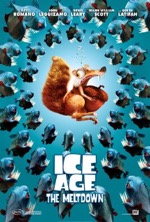
Starring: Ray Romano
March 2006
“Frigid Sequel Lacks the Warmth of the Original”
As if Al Gore’s treatise on global warming, An Inconvenient Truth, wasn’t sufficient enough, the much publicized, highly controversial topic is now the centerpiece of an animated film; namely the sequel to Ice Age, subtitled The Meltdown. The movie, presumably, takes place a short time after the events of the first film and furthers the misadventures of Sid the Sloth (John Leguizamo), Manny the mammoth (Ray Romano) and Diego the saber tooth tiger (Denis Leary). Oh, and of course we can’t forget Skrit or his eternal quest to possess that one elusive acorn in the ever amusing series of silly sidebars.
As the title would suggest, the first movie dealt with prehistoric animals migrating at the onset of the ice age. This time around the ecological calamity is a melting glacier, which floods the ice plain and drives the creatures from their homes. While doomsayers sway susceptible dinos with apocalyptic warnings that the end of the world is at hand, hucksters like Fast Tony (Jay Leno) use such alarmist propaganda as a means of turning a profit; as one of the more interesting new characters, it’s too bad we didn’t see more of Fast Tony in the movie.
In a feeble attempt at expanding our knowledge of the prehistoric trio, the writers have introduced new challenges for each of the main characters to overcome. For Sid, the issue is his need for respect. Sid never receives any respect from his companions but he finally finds some when he encounters a tribe of mini-sloths, who abduct Sid and reverently dub him “Fire King.” Sid basks in their adulation until they attempt to sacrifice him over a pit of molten lava. No respect there! Sid must be the distant ancestor of Rodney Dangerfield.
Diego faces his greatest fear when the glacier starts melting; swallowing up the last patches of dry land, the encroaching water makes Diego’s passage to the other side of the valley a hair-raising one. In jest, Sid gives Diego this tip, “Land safe, water not safe.”
Manny’s plight is the most desperate; all evidence points to Manny being the last living mammoth. Manny is crestfallen over that grim reality until the company encounters Ellie (Queen Latifah), a female mammoth who hangs with two dimwitted, thrill seeking possum sidekicks, Eddie (Josh Peck) and Crash (Seann William Scott). Headstrong Ellie refuses to accept that she’s a mammoth (having been raised by possums, Ellie believes she is one), and challenges Manny’s asserted leadership at every turn. This might explain why mammoths are extinct.
The real trouble here, besides the contrived, gift-wrapped resolution, is that the movie has no antagonist. To be sure, there are several internal struggles which sustain viewer interest for a time, but the convenient climax effectively lifts the pressure cooker lid and releases any steam the movie’s been building. Other than the titular thaw, the only story element that ratchets up the tension is the intermittent danger presented by two deepwater creatures (the alligator-like reptiles may be a little too frightening for younger children).
The CG animation, which shows a vast improvement in quality over the first film, is the only element that’s superior in this appropriately dubbed sequel. The characters aren’t as fun or funny here, and even Skrit’s gags seem recycled. With the series already growing tired, one can only hope that 20th Century Fox will deep freeze the series until the studio can commission a script that will better service the characters and the audience. The last thing we need is for the once charming Ice Age to devolve into The Land Before Time.
Rating: 2
She’s the Man (PG-13)

Starring: Amanda Bynes
March 2006
“Gender-bender with a Twist of Teeny Bop”
Viola (Amanda Bynes) is an incurable teenage tomboy who would rather be playing beach volleyball than helping out in the kitchen, much to her mother’s eternal chagrin and disapproval. Viola is also an excellent soccer player, the best on the team in fact; but Viola’s dream of carrying her team to a championship is abruptly shattered when she learns that the women’s soccer team at her high school has suffered sudden death.
Viola’s mother isn’t very sympathetic when she receives the “bad news;” with soccer cancelled, Viola’s mom strongly encourages the youth become involved with woman’s socials to learn the finer points of being a woman. When Viola stubbornly refuses, her exasperated mom replies, “Sometimes you’re just like your brother.” In that instant, a plan coalesces in Viola’s mind; her twin brother, Sebastian (James Kirk), will soon be taking an extended trip to Europe, leaving an open roster spot on the men’s soccer team at the upper-crust academy he attends.
Yep, you can guess what happens from here. Gender confusion creates most of the problems, and humorous situations, in the movie, i.e.: Viola falls in love with her hunky roommate, Duke (Channing Tatum), while the hottest, most popular girl in school, Olivia (Laura Ramsey), falls for Viola…disguised as Sebastian. There’s an amusing scene at a carnival where Viola, as herself, anticipates a rapturous lip-lock with Duke, who’s manning a kissing booth. As fate would have it, Duke is rotated out one girl before Viola. Dejected, Viola changes back into her Sebastian disguise, but then her mom shows up and she has to quickly change back; the scene recalls Robin Williams’ cross-dressing high jinx in Mrs. Doubtfire. The nerve-wracking complexities of leading a double life are painfully multiplied when Sebastian arrives home a day early and inadvertently ruins all of Viola’s well-laid plans.
Bynes does an amazing job of approximating male speech and mannerisms; the movie’s success is largely due to her role-reversing performance. Her comedic timing is dead-on, especially in the scene where Duke’s friend discovers her stash of tampons and she has to quickly improvise her way out of the jam—funny stuff!
Though She’s the Man is little more than a teenybopper movie, which is loosely based on Shakespeare’s Twelfth Night, the excellent lead performance in tandem with a surprisingly respectable plot renders the movie enjoyable instead of merely tolerable. I commend the film for steering clear of any uncomfortable or controversial issues: there is gender-bending without breaking in a storyline that could’ve crossed lines, but didn’t.
She’s the Man is a bona fide crowd-pleaser, a popcorn movie in the truest sense and a message-free examination of the life of one teenage girl. Uh, boy. Uh, girl.
Rating: 2 1/2
The Shaggy Dog (PG)

Starring: Tim Allen
March 2006
“Sophomoric Silliness Abounds in Canine Resurrection”
If ever there was an ill-advised remake, The Shaggy Dog is it—actually the story has been rehashed so many times now, they need to put the poor old dog to rest once and for all. The original, released in 1959 and starring Fred MacMurray, Tommy Kirk and Annette Funicello, was a light, whimsical tale of a boy who could transform into a sheepdog by chanting an ancient spell. It was campy and had Disney’s family-friendly cheese slathered all over it, but the comedy fit the period and the story worked as an endearing testament to bravery and self-discovery.
Today’s audience, however, is much more sophisticated than that of decades past, and the new film, though star-studded (Tim Allen, Kristin Davis and Robert Downey, Jr.), lacks the insouciant charm of the original. In this version, Deputy D.A. Dave Douglas (Allen), is bitten by a 300 year old dog and transforms into a canine at Pavlovian intervals. As a dog, Dave gains a different perspective on himself (specifically his selfish and neglectful tendencies), his family and the world around him. Dave begins exhibiting strange behaviors, such as lapping up his cereal and growling in the courtroom. As silly as those moments are the parent/teacher scene, where Dave runs outside to tree a cat, and the scene where he steamrolls an old lady while pursuing another cat, are the height (or, more appropriately, depth) of inanity.
Davis (Sex and the City) is mere set-dressing in the movie. She just seems to stand around and scratch her head at her husband’s bizarre transformations; an egregious waste for such a skilled actress. Downey, Jr. plays a mad scientist who seeks to discover and patent the fountain of youth; capturing the ancient dog gives him the means to accomplish this lofty goal, but what could have been a meaty turn as a nefarious antagonist is reduced to a series of courtroom antics tantamount to Allen’s high jinks. Danny Glover and Jane Curtain are also among the cast—the D.A. and judge, respectively—but their considerable talents are wasted by director Brian Robbins and the wafer-thin screenplay which was, ironically, churned out by a team of eight writers.
Allen’s performance here has redefined the word “stereotypical.” This is the same old shtick he’s been getting by with for years, and if anything, it’s more obnoxious and less enjoyable than before. In the movie, Dave has a heightened sense of smell and the ability to converse with animals; too bad the actor playing him wasn’t perceptive enough to recognize an embarrassing role replete with remedial gags and cheap laughs.
The end result of The Shaggy Dog is similar to taking a poodle in for grooming—you don’t leave with very much. If the movie has a saving grace, it’s that it doesn’t overstay its welcome; kids will love it, but most adults will be glad when it’s Rover.
Rating: 1 1/2
Failure to Launch (PG-13)
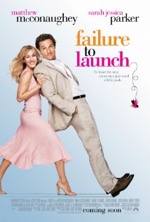
Starring: Matthew McConaughey
March 2006
“Aptly Named Rom-com Never Gets Off the Ground”
From a marketing standpoint, someone should’ve pointed out the dangers of using such a negative word in the title: failure. Besides the negative connotation the word conjures up, the potential for a self-fulfilled prophesy should have prompted studio executives to demand—in no uncertain terms—a name change. As things stand, the titular condition is the perfect diagnosis for the movie’s halfhearted performances and a story that, despite its best efforts to take flight, never achieves liftoff.
Finding anything redeeming here, much less entertaining, is nearly impossible. For starters, Matthew McConaughey and Sarah Jessica Parker have absolutely no chemistry whatsoever, which makes buying into the romance subplot extremely difficult. Also, Tripp’s (McConaughey) overprotective parents—meddling mom, Kathy Bates and daft dad, Terry Bradshaw—are one breakdown shy of the loony bin. This, of course, begs the question of why an adult would choose to live with such certifiable progenitors. One can only put up with so much in exchange for free room and board. I mean, if my father insisted on walking around the house in the buff as Tripp’s dad does (for several excruciating, eye averting minutes of onscreen time) I’d pack my things and take up residence on a friend’s couch before you could say nudist.
Tripp’s buddies play the usual well-meaning, advice-giving friends, but are one-dimensional stock characters whose sole purpose in the movie is to provide comic relief. The only peripheral cast member who actually offers some depth of character is Paula’s (Parker) sister, Kit (Zooey Deschanel). Kit is a lonely young woman with real emotions and real needs. A movie centered on her character’s plights would have been eminently more satisfying.
The movie has a modicum of clinical psychology and a ton of hyper-real situations that are designed to keep the audience rolling in laughter for two hours so that they don’t realize that they’ve been duped into enjoying a movie that has no plot. Failure to Launch is a prime example of what ails modern comedy films: it delivers the sizzle when audiences paid for a steak.
In all fairness, there are a few scenes that divert attention away from the insipid love story and the dysfunctional arrangement on the home front, but these moments are few and far between. Though the paintball skirmish and rock climbing wall excursion add some much needed energy to the stuck-in-neutral narrative, both sequences rely too heavily on standard comedy gimmicks and only garner cheap laughs which make them instantly forgettable. Sad to say, but either of these “action” scenes could be dropped into any other modern rom-com and they would work just as well. As such, Failure to Launch is just another “template” story (see my review for Eight Below).
In the end, Failure to Launch desperately tries to be clever but fails miserably with its anemic screenplay and characters that annoy more than they interest. Even the movie’s considerable star power couldn’t deliver enough thrust to get the leaden plot payload off the ground. Hollywood, we have a problem…we need a better script!
Here’s a scary thought: with the earth’s increasing population and the diversity of styles and tastes that pervade our culture, Failure to Launch is bound to be someone’s favorite film. Be very afraid!
Rating: 1 1/2
16 Blocks (PG-13)
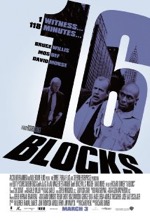
Starring: Bruce Willis
March 2006
“Dark and Gritty, But Not Sin City”
In Richard Donner’s 16 Blocks, Bruce Willis plays Jack Mosley, a haggard, beleaguered NYPD detective who drinks on the job and hobbles around on a bum leg—in other words, the very antithesis of John McClane from Willis’ Die Hard movies. And yet, this is one of Willis’ most refreshing roles in ages; by playing against type, he may have just rejuvenated his career…at least until the release of Die Hard 4.
The movie’s premise is basic enough—Jack must transport a witness, Eddie Bunker (Mos Def), sixteen blocks to the courthouse so that Eddie can testify and bring down six bad cops—but hit men and Jack’s crooked ex-partner, Frank Nugent (David Morse), make the sixteen blocks a serpentine maze of high stakes and narrow escapes. The time constraint (Jack must get Eddie to the courthouse in less than two hours) amps up the drama and a nicely executed twist near the movie’s climax hoists the movie to a level just above the standard action/thriller.
Though the bus sequence reminded me too much of Speed, some of the other action scenes were exceptionally well-crafted; like the hit on Jack’s car while he’s in the liquor store, or the stand-off in the bar or the shoot-out behind the restaurant, which is preceded by an intense verbal sparring match between ex-partners (Frank implores Jack to look the other way and hand over the kid).
Bullets are cheap in the movie, but between pulse-pounding action sequences a fair amount of attention is given to character analysis; such as Eddie’s perpetual death grip on his notebook. We eventually learn that the book is full of recipes—Eddie’s dream is to open a bakery where “every day is a birthday.” Eddie’s nasal delivery gets old after five minutes and his obnoxious blustering gets old even quicker; there’s only one instance in the movie where his effusive small-talk comes in handy…the rest of the time it nearly gets him and Jack killed. At times, you have to resist the urge to yell, “Shut up, already!” at the screen (a fellow spectator remarked, “The trick is to keep him from being killed without killing him.”). Perhaps Jack said it best, “Life’s too long and it’s people like you that make it longer.”
Jack is a fascinating, multi-layered protagonist: he tells Eddie, “I’m not a good guy,” yet when he tape records his last will and testament Jack claims that he’s “trying to do a good thing,” and certainly follows through with that intention at the movie’s climax. One thing I don’t like about the movie (other than Eddie’s excessive chin-wagging) is Jack’s change of heart—it’s a good twist and makes for a pseudo-happy ending, but it lifts the lid on the pressure cooker, effectively letting out any steam the movie had been building. If Jack had come to his senses and decided to change his ways earlier, Eddie would have been imperiled far less and fewer casualties would have been suffered along the way…in essence, Jack’s reformation makes all of the bullet showers and, in fact, Eddie’s very presence in the movie, utterly unnecessary.
Eddie’s parting encouragement to Jack, “People can change,” is a bit maudlin, but the point is well-taken; especially for typecast action stars desperately in search of a hit. 16 Blocks is a gritty urban drama that will satisfy hard-core action fans but will probably loose the rest of its audience somewhere between the precinct and the courthouse.
Rating: 2 1/2
Joyeux Noel (PG-13)

Starring: Diane Kruger
March 2006
“Inspiring True Account of History’s Most Miraculous Truce”
Based on the incredible true story of the night peace and good will visited the trenches of French, Scottish and German soldiers during WWI, Joyeux Noel (aka Merry Christmas) chronicles the events surrounding history’s most astonishing ceasefire. On Christmas Eve, 1914, a German tenor started singing “Silent Night” and, upon recognizing the sacred Christmas carol, French and Scottish soldiers added their voices to the multicultural chorus from across the blood-soaked, corpse-littered battlefield. A miraculous event transpired when white flags ascended and soldiers from both sides descended upon the soiled plain; soon mortal enemies were communicating with each other (with only gestures in some cases), trading valuables and proudly showing off pictures of loved ones.
At the conclusion of a solemn Latin mass officiated by a Scottish priest, the three leaders had a summit and mutually agreed to lay down arms and sort out the fallen soldiers the next day. On Christmas day, one soldier ironically observed, “We’re burying the dead on the morning when Christ was born.” The day after Christmas presented a perplexing challenge as many of the soldiers on both sides struggled with resuming combat—men with whom they had played a friendly game of kickball the day before were now lined up in their crosshairs. Having seen the face of the enemy, many were reticent or flat-out refused to fight.
The irony of the story is how perspective can paint or taint our reality. For many of the soldiers, once the floodgates of friendship and mutual understanding had been flung aside, there could be no going back to the clear-cut, good guys/bad guys patriotism that prevailed in their home countries. The repercussions of treating the enemy with the tiniest shred of humanity were severe—most of the soldiers were sent home in disgrace, branded as traitors and replaced by fresh troops who were all too eager to raise the Sword of the Lord against the unholy hoard that was the German army. Though this makes for a bittersweet ending, Joyeux Noel, as a whole, is uplifting and inspirational, and the movie’s salience, in light of current events, is profound.
Despite the exemplary effort exhibited by the costuming, props and art departments, the movie suffers from slow pacing and static direction from writer/director Christian Carion, especially in the early goings. The only familiar face among the cast is Diane Krugger (National Treasure), who plays Anna Sorensen, an opera singer and wife of the German soldier who initiates “Silent Night.” The rest of the cast is comprised of foreign actors who adequately inhabit their roles with three standout performances: the singing German soldier, the French commander and the Scottish priest, who is the beneficiary of the best lines in the movie.
Joyeux Noel will undoubtedly find its place among the vast catalog of seasonal treasures, but the movie will be remembered more for its political commentary than for its Christmas-related story elements, which, though vitally important, comprise a very small part of the overall plot. They say music is the universal language, and if sworn enemies can find fellowship and common ground in the midst of the hellish realities of war, the adage is supremely accurate.
Rating: 3
Eight Below (PG)

Starring: Paul Walker
February 2006
“Standard Arctic Survival Tale Will Leave You Cold”
Most desktop publishing applications for computers come with templates or wizards—quick helps that allow the user to customize pre-existing models, often in order to save time and effort. When it comes to storytelling, there are a limited number of plots (templates), but what makes each story unique is the location, the execution of the plot, the different types of characters and how those characters interact with each other.
In the case of Disney’s new “based on a true story” family film, Eight Below, the writers and producers—in what they probably thought was a low-risk, high-profit move—have simply given us the template itself. Arctic (or Antarctic) survival stories have been done so many times that anyone attempting such a project should approach it with a great deal of caution and trepidation…and more than just a few original ideas. Unfortunately for Eight Below (which is really a misnomer—eight refers to the number of sled dogs, but the temperature dips well below minus fifty degrees in the movie), it offers nothing new, but banks on cute dogs and maudlin moments to bail out the unoriginal screenplay and uninspired performances.
Jerry Shepard (Paul Walker) and his colorful companions, motor-mouth, Charlie Cooper (American Pie’s Jason Biggs) and Native American hottie, Katie (Moon Bloodgood), work at a base at “the bottom of the world.” Jerry, an experienced survival guide, begrudgingly transports American geologist Davis McClaren (Bruce Greenwood) to nearby Mt. Melbourne, where meteorites from Mercury have reportedly landed. Along with his team of well-groomed, well-trained dogs, Jerry totes McClaren and his equipment across the frozen, Antarctic plain, which is filled with bottomless crevasses, patches of thin ice and frightening leopard seals. The expedition is cut short when a massive snow storm moves in; the race home nearly costs McClaren his life (I wish I had a dollar for every time he falls in the movie) and Jerry’s fingers to frostbite. The base is evacuated and the dogs are left behind with the intention of immediately returning for them, but the severity of the blizzard prohibits any flights from returning to the base until the next spring. What ensues is tantamount to The Incredible Journey as the dogs break free from their chains, work together as a team, and feast on seagulls and a beached killer whale (the best visual in the movie) until they’re rescued by Jerry and his reassembled team…some 180 days after being stranded.
Director Frank Marshall does an adequate job with mediocre material; a script suggested by the real life Japanese expedition to Antarctica in 1957. Unfortunately, Marshall doesn’t receive any assistance from his gelid, no-name cast, and in the end, it’s only the sled dogs that are remotely memorable (Mya in particular). Some would argue that this formula still works, judging from the sniffles heard among the audience at tear-inducing moments, but this brand of sentimental survival tale reached its height somewhere in the late 70’s with the Robert Logan pictures. Suggested improvements for the sequel: have the dogs deliver the lines and let the leopard seal eat McClaren.
Rating: 2
The Pink Panther (PG-13)
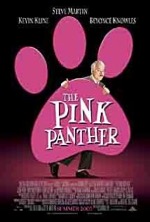
Starring: Steve Martin
February 2006
“Martin is Most Amusing When He Doesn’t Have a Clue”
Inspector Jacques Clouseau has been on quite a sabbatical. Last seen in 1993’s Son of the Pink Panther, it had been nearly twenty years before that when the brilliant Peter Sellers had finally hung up his detective’s hat after successfully playing the clumsy Clouseau in all four of the original Pink Panther movies.
This Pink Panther caper opens at a World Cup finals match between China and France in Paris. When the revered French coach is murdered by a poison dart at the conclusion of the contest and the famous Pink Panther diamond turns up missing, French police immediately launch an investigation. Chief Inspector Dreyfus (Kevin Klein) hatches a plan to catch the killer, an accomplishment that will solidify his claim on the elusive Medal of Honor—Dreyfus has been passed up for the coveted prize seven times. Dreyfus’ plan is to commission an incompetent cop to distract and divert the killer while he and the finest team of investigators in all of France nab the miscreant. The “perfect man” for the job is Jacque Clouseau (Steve Martin), a bumbling idiot and walking calamity, who mistakenly thinks his promotion to the rank of inspector is based on merit. What ensues is a witless investigation brimming with gags, double entendres and abject lunacy. Half the time I rolled my eyes, the rest of the time I was rolling on the floor at Martin’s unrelenting antics—he was the perfect choice to play dunderheaded Clouseau.
The movie’s storyline is essentially one catastrophe after the next. Some of my favorite moments are Clouseau’s alternate good cop/bad cop routine, Clouseau’s conversation with the Asian woman and the scene where Clouseau and his deputy sneak into Dreyfus’ ball in disguise. The movie’s creative highlight is when Clouseau crosses paths with 006—besides being uproariously funny, the scene features a nice bit of surprise casting.
And speaking of casting, the supporting characters add wonderful color and texture to the film, especially Ponton (Jean Reno), Clouseau’s vigilant deputy, Nicole (Emily Mortimer), Clouseau’s love interest, Xania the singer (Beyonce Knowles) and Yuri the trainer who trains (Henry Czerny). Martin and Klein are brilliant together, as are Martin and Reno; the scenes where Clouseau initiates random attacks on the deputy are idiotic and yet I still laughed. Perhaps that’s the film’s secret weapon; even when you don’t want to laugh, you end up doing it anyway…the movie is insidious that way.
Though The Pink Panther is replete with slapstick silliness, it’s also one hundred percent entertaining. Whether or not box office returns warrant a sequel, Martin’s Clouseau tickled me pink!
Rating: 2 1/2
Firewall (PG-13)
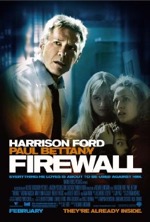
Starring: Harrison Ford
February 2006
“High-Tech Thrill Ride with an Old Ford”
Last seen in Hollywood Homicide (or rescuing disoriented hikers with his helicopter); Harrison Ford has staged a significant comeback with Firewall, a taut cyber-thriller from writer Joe Forte and director Richard Loncraine. In my review for Hollywood Homicide, I wrote, “Unlike some naysayers, I believe there’s still gas in the old Ford, but he needs to choose better films to act in…” Firewall is definitely “better” than his last outing, and though it fails to reach the level of intensity found in Air Force One, the movie is familiar territory for Ford and is, therefore, an ideal way for him to ease back into the routines and rigors of the biz.
Jack Stanfield (Ford) is a bright, hard-working bank security system designer who also manages to find time to be a family man. Jack’s wife, Beth (Virginia Madsen), is an architect and stay-at-home mom who keeps a watchful eye on their two quarreling kids, Sarah (Carly Schroeder) and Andy (Jimmy Bennett), and loyal pooch, Rusty.
On a rainy night in Seattle (which one isn’t?), a man jumps in the back seat of Jack’s car (nitpick: most people entering a car by themselves only open their door), points a gun at Jack’s head and tells him to drive home. Meanwhile, Beth answers the door for the pizza man and is accosted by several men toting guns and high-tech equipment. When Jack arrives at his home, he finds his family tied and gagged in the kitchen and a center of operations with fully-functioning computers and monitors set up in his living room. The leader of the outfit is a man named Cox (Paul Bettany in a typecast shattering role); he and his minions have been spying on Jack and his family for months in preparation for this heist. The plan is simple; while Cox and crew make themselves at home in Jack’s sprawling, beachfront mansion, Jack will go to work like normal and devise a way to hack into the system he designed. Jack must steal a hundred million dollars (virtual money) from the bank’s wealthiest investors, or his wife and children will be killed. The balance of the movie sees Jack scrambling to keep his family safe, while devising a way to prevent cold-blooded Cox (he kills his own men when they fail him, a la Vader) from getting even a dime.
The movie may be a tad slow out of the blocks, but once Cox initiates his plan, the movie transforms into a first-rate thriller where the hero has to stay one step ahead of the bad guys…or else. Ford enjoys solid support from Bettany and Madsen (Alan Arkin and Robert Patrick are throw-away characters, unfortunately, but 24’s Mary Lynn Rajskub plays a significant part as Jack’s secretary), but it’s his performance that really carries the movie. The character of Jack Stanfield isn’t as self-confident as Jack Ryan, nor is he as resourceful as Indy or as plucky as Han, but he’s really more interesting because he’s an “Average Joe.” The strength of this Jack is his “every day guy” appeal, which services this storyline far better than if he was one of those other guys—cut from hero’s cloth.
If the movie has a message, it’s that elaborate schemes can be quickly undone by everyday or unsuspected pieces of technology. Here are some examples: Cox puts a pen with a spy camera in Jack’s breast pocket to keep tabs on him, but Jack quickly figures out how to dump it off to a co-worker. Jack stages an escape in his house by using Andy’s remote controlled car to create static on the Cox’s security monitors. Jack uses Sarah’s iPod to download the account numbers of prominent bank lenders (to the machine, they’re just files), but Jack, wisely, takes a picture of the monitor screen with a cell phone and later returns all of the stolen money to the proper accounts from an airport bank. Jack ultimately finds Cox and his kidnapped family in an abandoned country house thanks to Rusty’s dog collar, which contains a G.P.S. sensor that can be tracked from the internet.
Despite gaping plot holes (i.e. Cox’s entire, ill-advised plan, which is made laughable when one considers the abundance of advance intel he had at his disposal), Firewall is an edge-of-your-seat thriller that climaxes with an old-fashioned fist fight and a heart-warming family reunion. Ford’s movements may be a little stiff, especially during action sequences, but he’s still the man. Welcome back, Harrison; don’t be a stranger!
Rating: 3
Curious George (G)
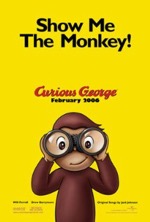
Starring: Will Ferrell
February 2006
“Curiosity Killed the Cat…But Not This Silly Simian”
First introduced in the 1941 illustrated children’s book by authors H.A. and Margaret Rey, Curious George is a simple character in a simple story from a simpler period of American history—a throwback to a more innocent age. What’s refreshing about George is that he doesn’t speak (unlike Disney’s vociferous menagerie); conveying emotions through gestures and facial expressions, he’s a more realistic and captivating alternative to the cutesy animated animals we’ve been subjected to in recent years. The movie remains faithful to the books, though some modifications have been made; the most notable change is that The Man in the Yellow Hat has been given a name...Ted.
Ted (Will Ferrell) works at a museum owned by Mr. Bloomsberry (Dick Van Dyke), a doting curator who favors Ted over his real son, Jr. (David Cross). With the museum in financial trouble and in desperate need of a new exhibition, Ted volunteers to join an expedition to retrieve the mythical idol at the Lost Shrine of Zagawa in Africa. Ted first encounters George when the monkey grabs his yellow hat, mistaking it for a banana. After Ted finds the idol and returns to the ship, George stows away and follows Ted all the way back to his NYC apartment. George immediately complicates Ted’s life by hand painting a neighbor’s flat, which results in man and monkey being evicted from the building. Matters go from bad to worse when Ted arrives at the museum to find a massive platform that’s been custom-built for the reportedly giant-sized idol (the actual idol fits firmly inside the palm of his hand). As restless patrons clamor to see the opening of the exhibit, Ted must enlist the help of an eccentric scientist, Clovis (Eugene Levy), and an attractive teacher, Maggie Dunlop (Drew Barrymore), to fend off Jr.’s efforts to discredit him, discover the “real” idol and somehow prevent George from destroying everything in sight before the museum is forced to close for good.
An element that really stands out in the movie (other than Jack Johnson’s cookie-cutter songs) is the vibrancy of the pastel palette employed by the artists and the ethereal rays that bathe the characters wherever sunlight is present. This warm glow, in tandem with the minimalist animation style, produces a serene mood that works in perfect harmony with the lithe and blithe storyline.
Though clearly geared toward pre-teens, there’s plenty here for adults to enjoy as well: take the jaded cabbie, for instance, who takes a cue from Tom Hanks in A League of Their Own when he yells, “There’s no screaming in cabs!” The shifty clerks who sell Ted a yellow outfit are also amusing; needing to clear out their inventory they claim that “yellow is the new khaki.” Though the blissful balloon rescue is a highlight in the movie, it’s really the trouble-making monkey’s boyish innocence that makes the movie soar.
Rating: 2 1/2
The World’s Fastest Indian (PG-13)
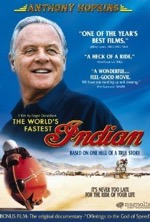
Starring: Anthony Hopkins
February 2006
“High-octane Biopic is Built for Speed”
The true story of intrepid Kiwi motorcycle racer, Burt Munro, is an inspiring journey of courage, determination and unyielding passion in the face of persistent adversity. Pushing his heavily modified, highly-experimental 1920 Indian Scout bike to insane velocities, Burt was built for speed. He tells Thomas, the neighbor boy, “You live more in five minutes on a bike going flat out than most people do in their lifetimes.”
Known about town as an eccentric hermit, Burt uses a power sander to file his toenails and an acetylene torch to heat a kettle of water for tea. He also pees on his lemon tree to help it grow. When Thomas’ father implores Burt to mow his lawn because it’s a disgrace to the community, Burt douses the ankle high grass with gasoline and sets it on fire. Some might mistake Burt’s quirky insouciance and hermit-like lifestyle for xenophobia, but nothing could be further from the truth. Burt’s the type of person who can make friends with anyone, anywhere, at any time. Individuals in pursuit of a dream generally attract a following, and so it is with Burt, who’s aided by a vast array of individuals as he makes his way from Invercargill, New Zealand to the Bonneville Salt Flats in Utah.
The culture shock Burt experiences when he reaches the US is poignant in an amusing way. Rude cabbies and soliciting prostitutes soon pale in comparison to the hotel clerk he encounters in Hollywood, a cross-dresser named Tina. Burt purchases a car from Fernando, who nearly has a coronary on the test drive when Burt drives on the wrong side of the road. When Burt’s jury-rigged bike hitch looses a wheel, a Native American named Jake helps with repairs and also gives Burt something to help with his failing prostate (a powder made from ground up dog testicles). Despite considerable and frequent setbacks Burt never once looses his sense of humor—his strength of will and persistence of vision fuel his drive to fulfill a lifelong dream.
Although it’s been said a dozen times before, this is one of Anthony Hopkins’ finest performances. Hopkins wholly inhabits Burt and endues the dotting daredevil with a dignity and morality that’s quite refreshing. Tour de force doesn’t even come close to describing Hopkins’ masterful turn; not only does he anchor the film, as the only marquee name in the cast, he is the film.
The World’s Fastest Indian is a gem of an indie flick that comes with a heartening reminder that it’s never too late to pursue a dream. The reason why Hollywood has been so heavily criticized for the frequently lacking body of work it produces? It doesn’t make enough movies like The World’s Fastest Indian. The film is a rare cinematic treasure that you’d do well to rush out and see.
Rating: 3 1/2
Last Holiday (PG-13)
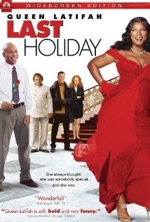
Starring: Queen Latifah
January 2006
“Delightful and Inspirational Carpe Diem Comedy”
“There are always possibilities,” or so the saying goes. Retail worker for Kragen department stores, Georgia Byrd (Queen Latifah), has an album full of dreams, labeled Book of Possibilities. In it are favorite recipes of foods she can’t eat, brochures to vacation spots she can never afford to visit and cut and paste fantasy wedding pictures of her and her hunky co-worker, Sean Matthews (LL Cool J). Georgia takes a picture of the meal she just created while watching her idol, Emeril Lagasse, on TV, pastes it in the album and wistfully dreams of all the things she could experience, if only…
One day at work, while trying to impress Sean, Georgia accidentally bumps her head and is taken to a nearby clinic. A CAT scan reveals that Georgia has multiple brain tumors…she’s given three weeks to live. After leading her congregation in a rousing, impromptu gospel song entitled “Why me, Lord?,” Georgia cashes in her bonds, heads for the Czech Republic and stays at Hotel Pupp (pronounced like the stuff dogs leave on lawns). While checking in, Georgia overhears that a big business meeting will take place at the hotel between corporation owner, Matthew Kragen (Timothy Hutton), his paramour, Ms. Burns (Alicia Witt), a congressman and the senator of Louisiana. At dinner, Georgia breezes into the hotel restaurant wearing a dazzling European dress and commands the attention of every waiter when she orders all four specials, which further elicits the attention of world-renowned Chef Didier (Gerard Depardieu), who immediately takes a liking to Georgia and later allows her to create meals in his kitchen. Assuming Georgia comes from money, the business party befriends Georgia and includes her in such activities as skiing, base jumping and gambling; Kragen tries competing with Georgia and ends up looking like a fool in each instance. While Georgia continues spending money, enjoying life and making new friends, Kragen, pays off a housekeeper to discover the secret to Georgia’s real identity.
A remake of Alec Guinness’ 1950 movie of the same name, Last Holiday features memorable performances from an assemblage of journeyman actors (and cameos by Emeril and Smokey Robinson) and a heart-warming story that analyzes the brevity of life without waxing preachy. In the history of cinema, there have been plenty of three-weeks-to-live plots, but none have been delivered with this much insouciant charm. Queen Latifah’s performance is remarkable as Georgia Byrd, a woman you just can’t help but admire for her spunk and new-found lust for life; emboldened by her terminal illness, Georgia tells another character, “I wasted too much of my life being quiet.” There’s a wonderful scene where Georgia looks into the mirror and tells herself that the next time “we will laugh more, love more, see the world…we just won’t be so afraid.”
From the colorful characters to the inspirational story to the on location footage shot in a cozy European village, there isn’t a single misstep in director Wayne Wang’s (Because of Winn-Dixie) feel-good flick. Last Holiday is an amusing tale wrapped around a subtle reminder to make the most of every moment. And to always get a second opinion!
Rating: 3
Glory Road (PG)
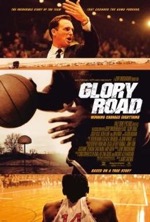
Starring: Josh Lucas
January 2006
“Inspirational Basketball Formula Still Works”
Last year’s model was Coach Carter, a “based on a true story” project spotlighting basketball coach Ken Carter’s extreme measures to build men of character out of his troubled inner-city players; a story that made national headlines in 1999. This year’s model, presented by Buena Vista studios and director James Gartner, chronicles Don Haskins’ (one time woman’s basketball coach and later Hall of Fame basketball legend, played here by an even-keeled Josh Lucas) visceral and controversial decision to start all black players in a championship game—something that, to that point, had never been done before. You don’t need a magnifying glass to see the movie’s social commentary with regard to racism, and its similarity to other sports films, Remember the Titans in particular, is an inherent weakness in the plot. However, it’s the strength of the story alone that salvages this familiar recipe (i.e. an underdog team that wins the championship) and bails out Lucas’ uninspired performance.
What bothered me more than Lucas’ flaccid acting, however, was Haskins’ lackadaisical leadership style (my interpretation of Haskins is strictly based on how the movie portrays him). Haskins, apparently, had none of the fire that Gene Hackman’s Coach Norman Dale had in Hoosiers (the quintessential film on the subject); far too often in the movie Lucas capitulates to his players, and though he preaches the fundamentals of the game (solid defense and no showboating), his overall lack of leadership presence was a constant irritant to me. The line, “They’re not going to give you anything…you’ve got to go out there and take it,” made memorable by the trailer, is one of the only instances in the movie where Lucas shows emotion of any kind. In fact, the only coaching acumen I detected in the movie was when Lucas taunts his players with various negative headlines written about his team as a means of getting them fired up for the big game.
Emily Deschanel (TV’s Bones), who plays Haskins’ wife, is nothing more than set dressing in the movie and Derek Luke (Antwone Fisher), who plays Haskins’ star performer, does a solid job with a two-dimensional character. The only standout performance in the movie is Jon Voight’s portrayal of revered and feared University of Kentucky coach, Adolph Rupp. Only eagle-eyed viewers will recognize Voight at first glance due to a nose appliance; the veteran actor, once again, proves that he can play anything.
Glory Road, the true story of how downtrodden Texas Western University won the NCAA championship game in the mid-sixties, is uplifting if not particularly original. The main problem here: after the goose bumps fade so will any memory of the film.
Rating: 2 1/2